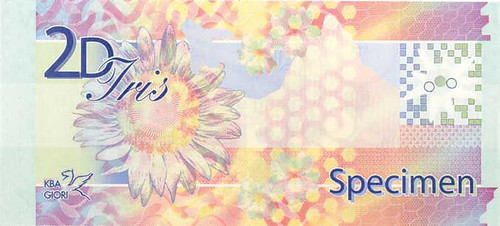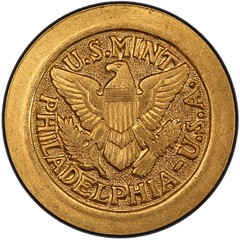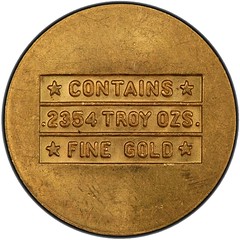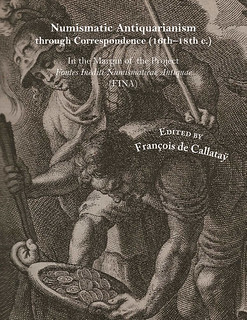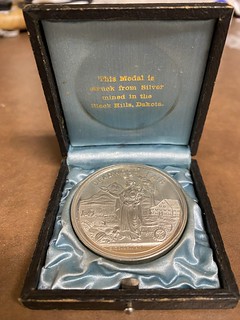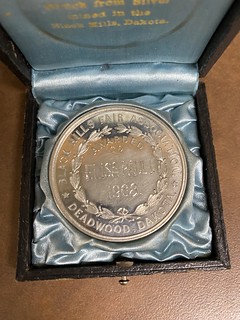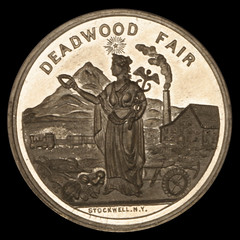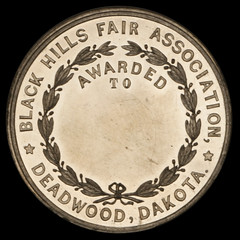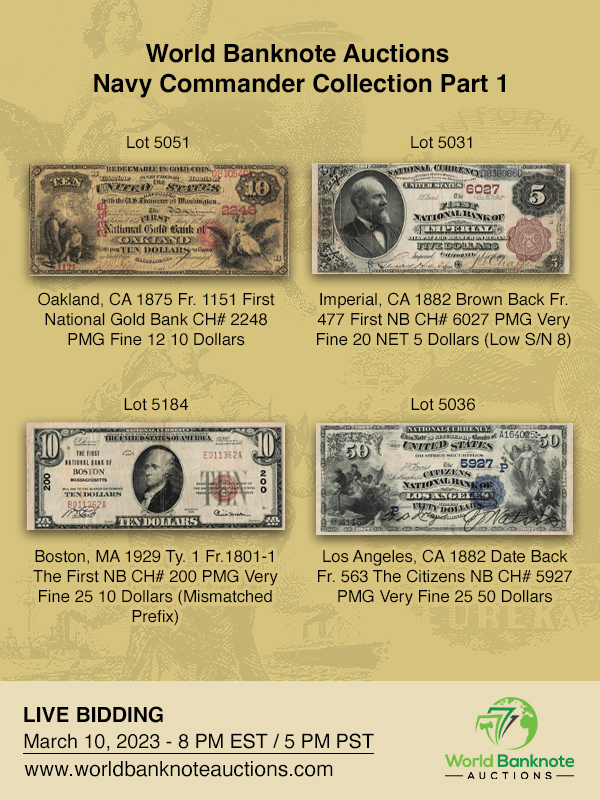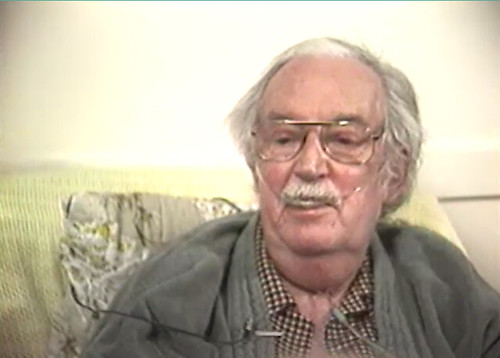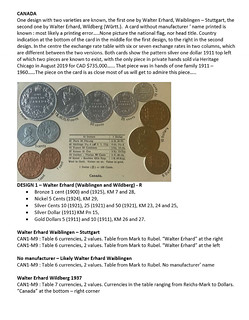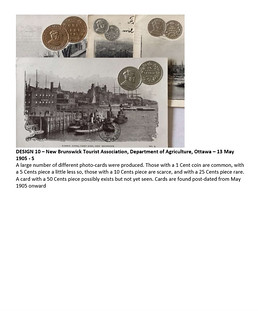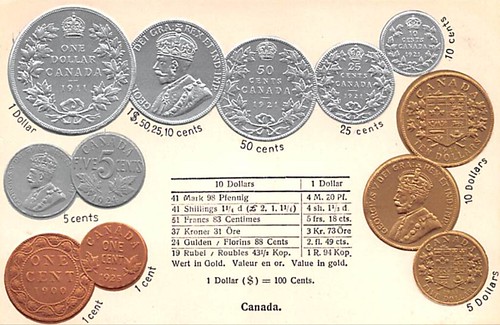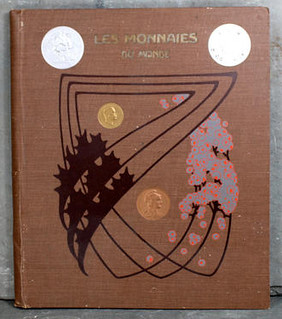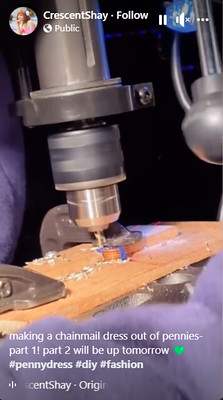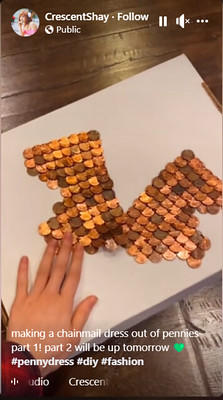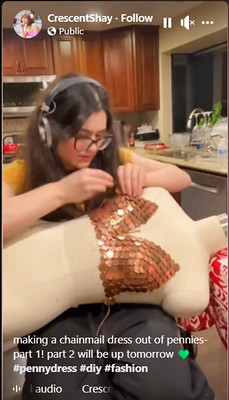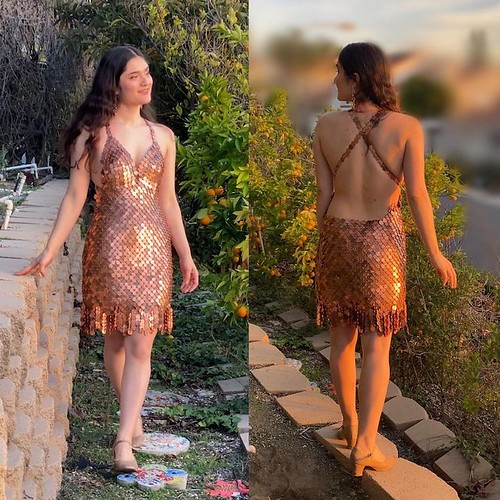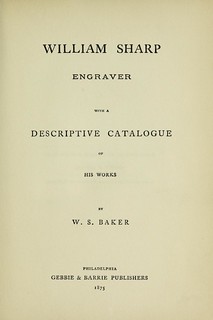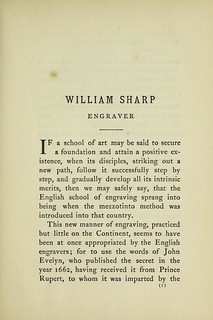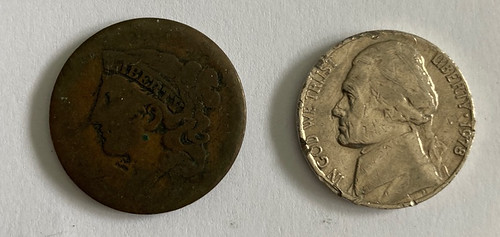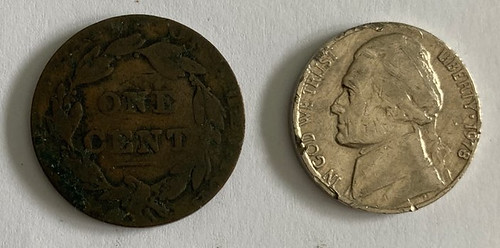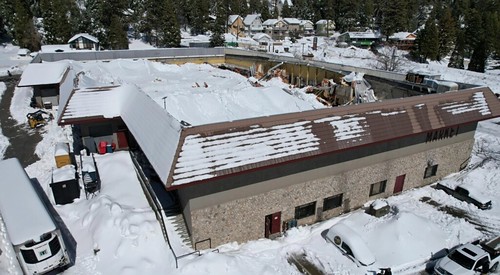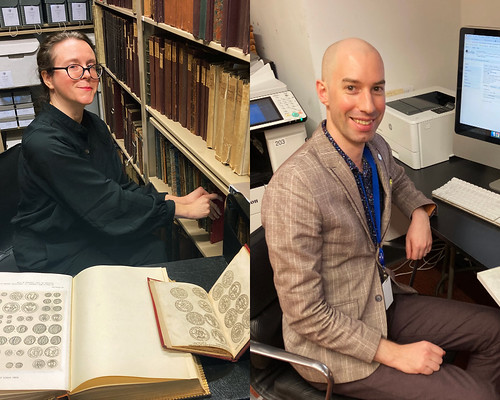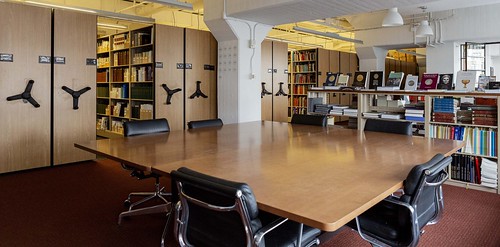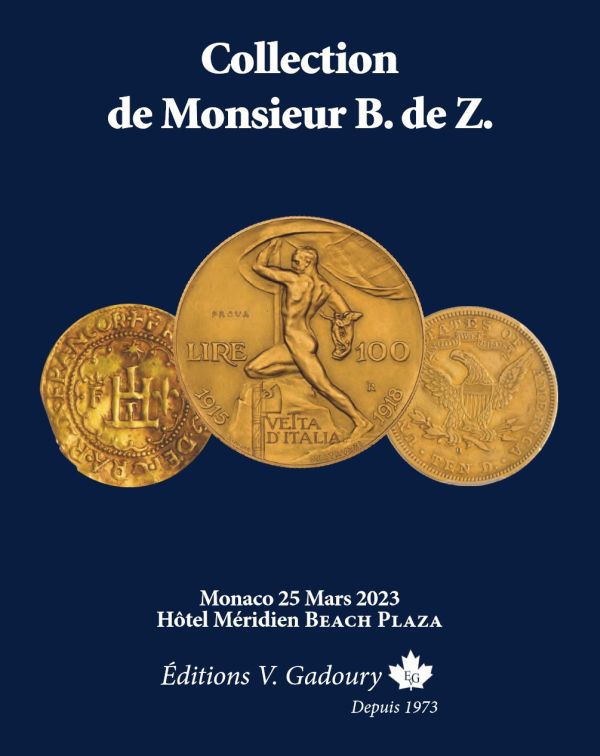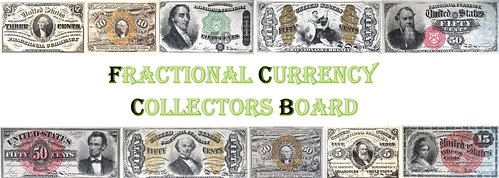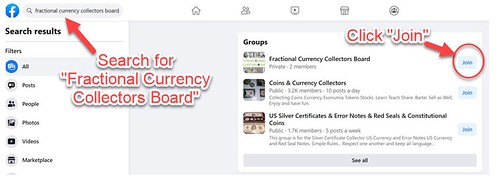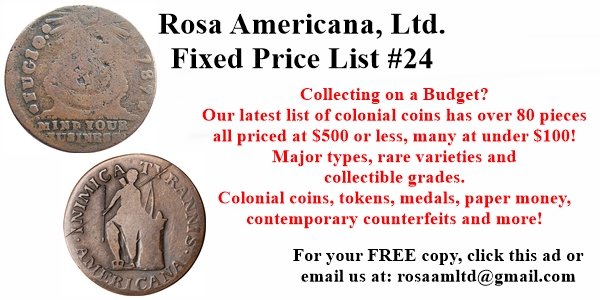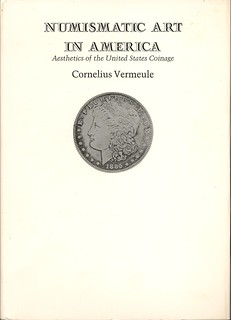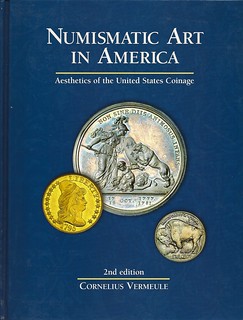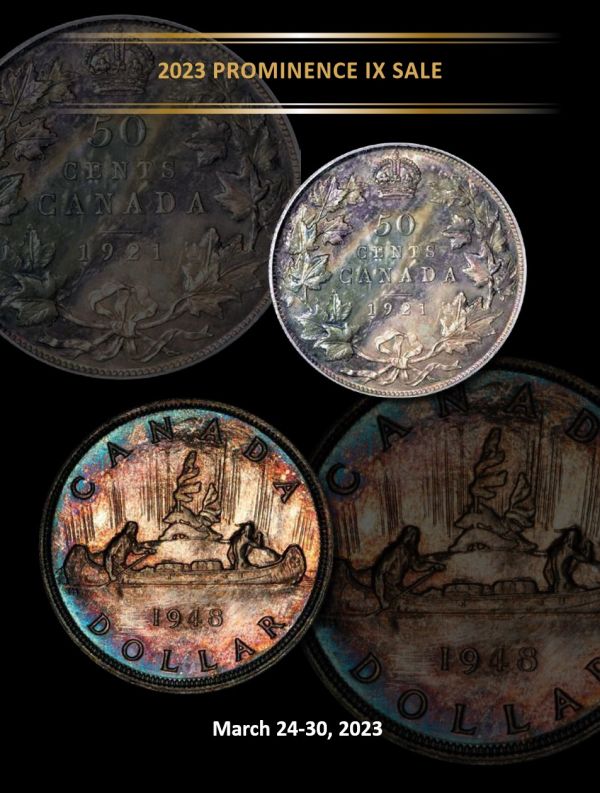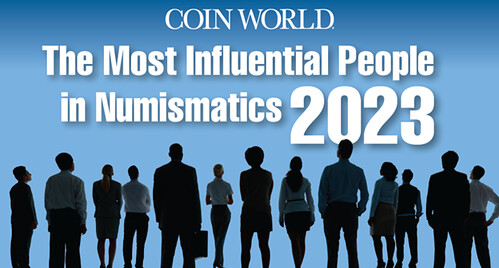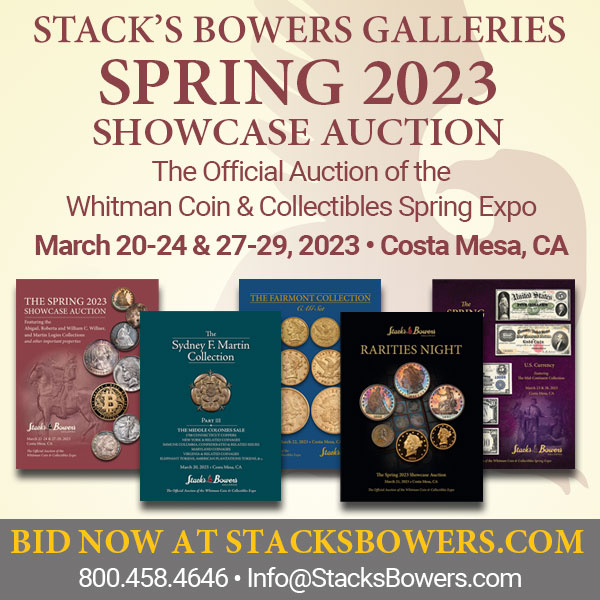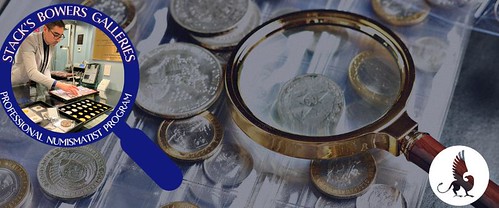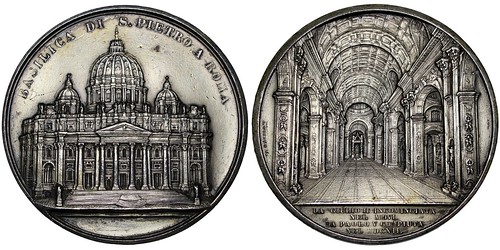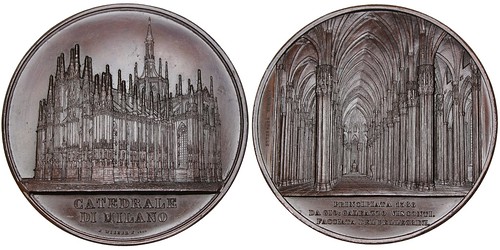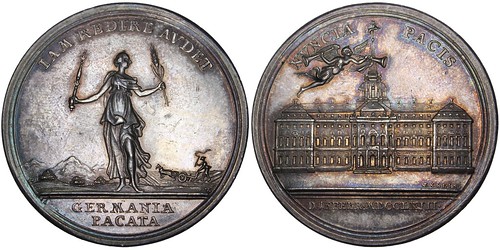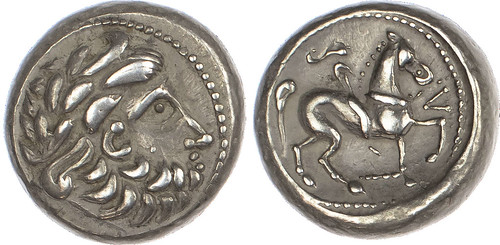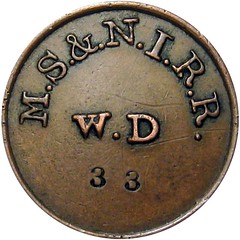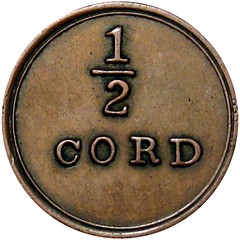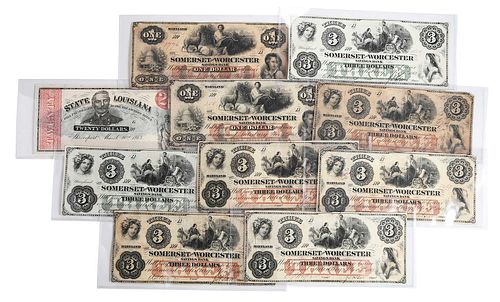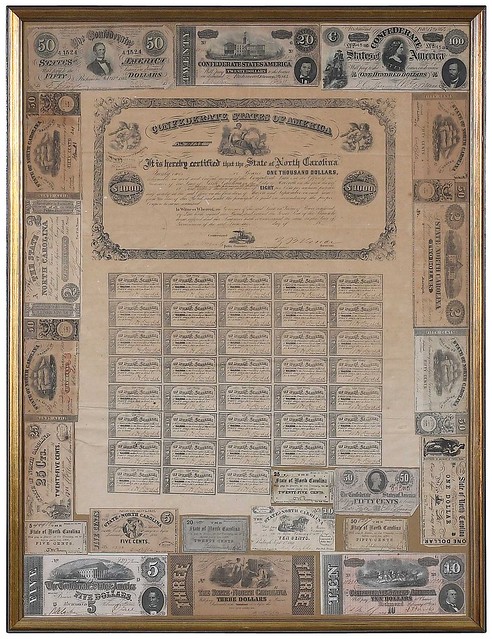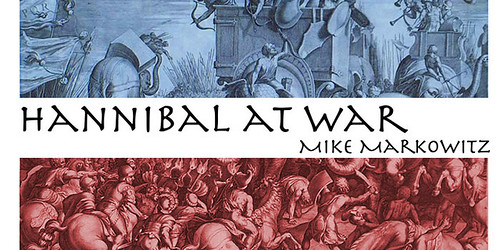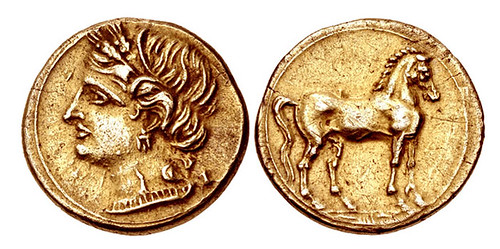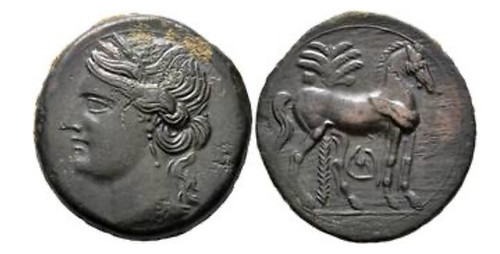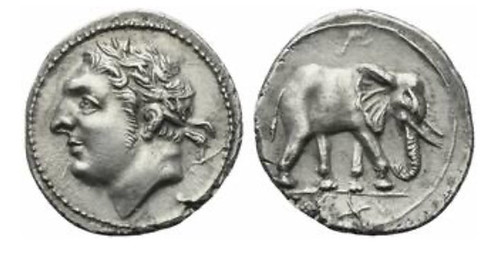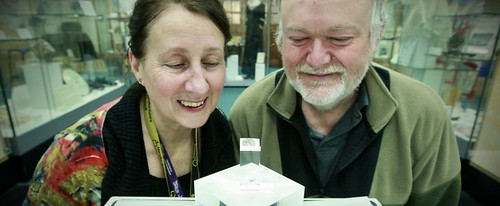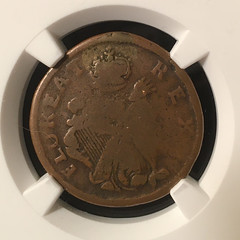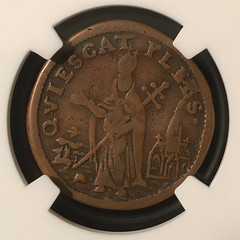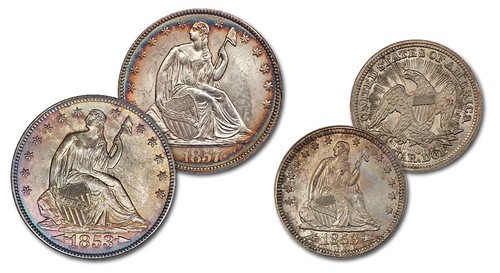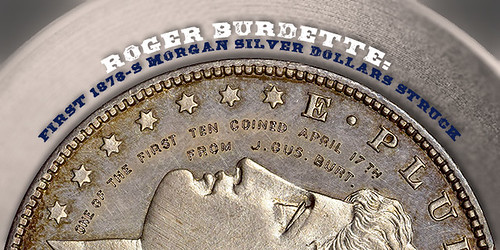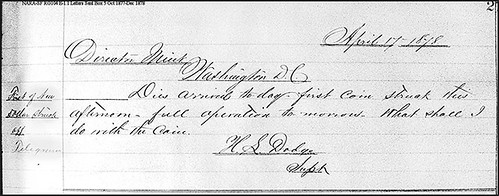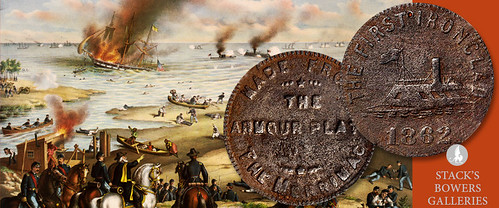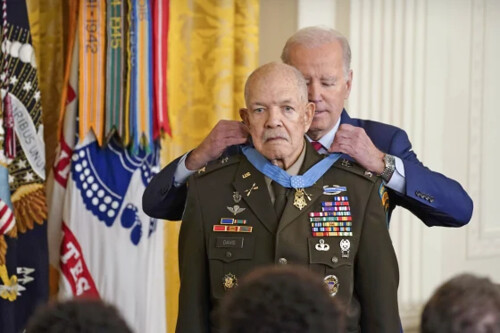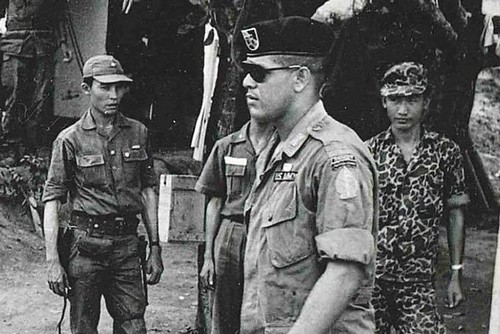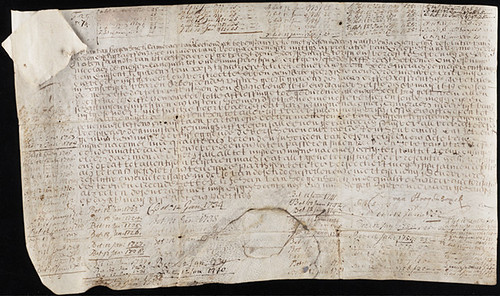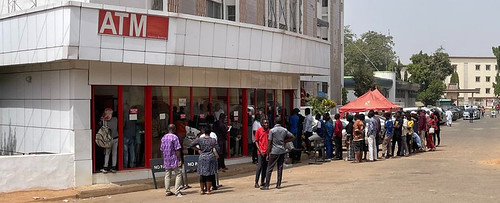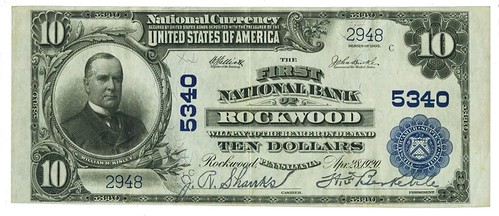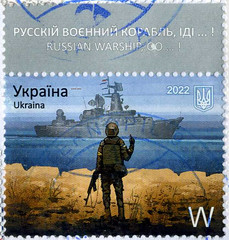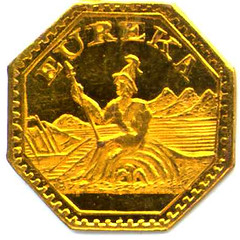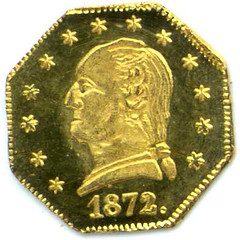
Visit our NBS Sponsors




About UsThe Numismatic Bibliomania Society is a non-profit association devoted to the study and enjoyment of numismatic literature. For more information please see our web site at coinbooks.org SubscriptionsThose wishing to become new E-Sylum subscribers (or wishing to Unsubscribe) can go to the following web page link MembershipThere is a membership application available on the web site Membership Application To join, print the application and return it with your check to the address printed on the application. Print/Digital membership is $40 to addresses in the U.S., and $60 elsewhere. A digital-only membership is available for $25. For those without web access, write to: Charles Heck, Treasurer AsylumFor Asylum mailing address changes and other membership questions, contact Chuck at this email address: treasurer@coinbooks.org SubmissionsTo submit items for publication in The E-Sylum, write to the Editor at this address: whomren@gmail.com BUY THE BOOK BEFORE THE COINSale CalendarWatch here for updates! |
- WAYNE'S WORDS: THE E-SYLUM MARCH 5, 2023
- NEW BOOK: SAUDI GOLD
- NEW BOOK: NUMISMATIC ANTIQUARIANISM
- RARE DAKOTA AWARD MEDAL SURFACES
- VIDEO: GLENN SMEDLEY
- MORE ON COIN POSTCARD ALBUMS
- NOTES FROM E-SYLUM READERS: MARCH 5, 2023
- ANS LIBRARY INTERNS WELCOMED
- RCNA LIBRARY MOVING TO NICKLE GALLERIES
- EXHIBIT: BIRTH OF PORTRAITURE: ALEXANDER THE GREAT
- NEW FRACTIONAL CURRENCY FACEBOOK PAGE
- VOCABULARY TERMS: MINTMASTER'S MARK AND MORE
- CORNELIUS CLARKSON VERMEULE III (1925-2008)
- 2023 COIN WORLD MOST INFLUENTIAL VOTING
- NEIL SHAFER MILITARY NUMISMATICS AWARD
- PNG 2023 YN SCHOLARSHIP COMPETITION
- STACK'S BOWERS PROFESSIONAL NUMISMATIST PROGRAM
- NUMISMAGRAM MEDAL SELECTIONS: MARCH 3, 2023
- NUMISMATIC NUGGETS: MARCH 5, 2023
- COINS OF CARTHAGE DURING HANNIBAL'S WAR
- OFFA COIN DONATED TO HEREFORD MUSEUM
- ACQUIRING A ST. PATRICK NEW JERSEY FARTHING
- LIBERTY SEATED ARROWS EXAMINED
- FIRST 1878-S MORGAN DOLLARS STRUCK
- THE U.S.S. MERRIMACK RELIC MEDAL
- MEDAL OF HONOR FOR COL. PARIS D. DAVIS
- 1648 PERPETUAL DUTCH BOND STILL PAYS INTEREST
- COURT HALTS NIGERIA'S BANKNOTE ROLLOUT
- ATMS DISAPPEARING ALONG WITH CASH USAGE
- 1948 CIA DOCUMENT DISCUSSING COUNTEFEITING
- LOOSE CHANGE: MARCH 5, 2023
- FEATURED WEBSITE: CALIFORNIA GOLD
Click here to read the thin version on the web
Click here to subscribe
Click here to access the complete archive
To comment or submit articles, reply to whomren@gmail.com
Content presented in The E-Sylum is not necessarily researched or independently fact-checked, and views expressed do not necessarily represent those of the Numismatic Bibliomania Society.
WAYNE'S WORDS: THE E-SYLUM MARCH 5, 2023
 New subscribers this week include:
Normand Pepin, courtesy George Cuhaj;
James Cavestro, courtesy Steve Hill;
Thomas Engelen, and
Gerald A Widstrom.
Welcome aboard!
New subscribers this week include:
Normand Pepin, courtesy George Cuhaj;
James Cavestro, courtesy Steve Hill;
Thomas Engelen, and
Gerald A Widstrom.
Welcome aboard!
Thank you for reading The E-Sylum. If you enjoy it, please send me the email addresses of friends you think may enjoy it as well and I'll send them a subscription. Contact me at whomren@gmail.com anytime regarding your subscription, or questions, comments or suggestions about our content.
This week we open with two new books, updates from the Newman Numismatic Portal, the American Numismatic Society and the Royal Canadian Numismatic Association.
Other topics this week include Alexander the Great, Cornelius Vermeule, Neil Shafer, Coin World's Most Influential, Hannibal, King Offa, relic medals, and the Medal of Honor.
To learn more about Saudi Gold discs, Numismatic Antiquarianism, the Dakota Award, Glenn Smedley, ANS Library interns, Nickle Galleries, Fractional Currency, misaligned dies, numismatic art in America, Bette Davis, the Milan Cathedral, cord wood tokens, the first Morgan dollars struck at San Francisco, disappearing ATMs, and World War Zero, read on. Have a great week, everyone!
Wayne Homren
Editor, The E-Sylum
NEW BOOK: SAUDI GOLD
Seneca Mill Press LLC has announced the latest numismatic book by Roger W. Burdette. -Editor
SAUDI GOLD and other Tales from the Mint
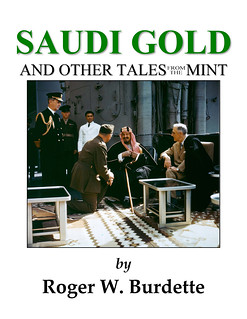 America's national numismatic journey began with tentative issues of
America's national numismatic journey began with tentative issues of Fugio
cents in 1787 and half dismes
in 1792. Over time, external events generated unexpected changes to accustomed financial and coinage systems. Some changes were of wide impact, while others were limited to our national mints, and some remain largely unknown to the present.
Saudi Gold and other Tales from the Mint explains use of gold as a single monetary standard, commonly accepted by most nations. But the United States, with its diverse and questioning population, attempted to have gold and silver as semi-exchangeable
if not practical dual standards.
After decades of mannered stability, a once ubiquitous gold exchange standard crumbled under international economic pressures resulting from World War I. American dollars that had long been expressed as gold dollar
or silver dollar
or greenback dollar
all became simply a dollar.
Coin collectors used their newly equal dollars to enhance collections, fill coin boards and examine pocket change for rare and valuable coins. The business of coins became part of the collection of
coins and drew within it a new diversity of hobbyists and businesses.
During the interwar Great Depression period, Treasury began a large construction and modernization plan for the mints. This included separate bullion depositories for gold and silver, enlargement of existing mints and a proposed new mint in Indiana. Director Nellie Ross reinvigorated the Mint Service with better training, heightened security, improved facilities and crucial direct oversight.
With World War II came new, often secret roles for the Treasury and Mint Bureau. Saudi Gold and other Tales from the Mint describes how they became lenders of war materials, international coin producers, and unexpected sources of foreign aid designed to improve America's war efforts. The Department of State seemed, at times, to use the Mint Bureau as its own adjunct; bypassing a Congress reluctant to take a long view of international relations.
World War II produced the greatest single disruption of human activity ever experienced. The rise of large-scale totalitarianism, weapons of unimaginable destructive capability, and economic distortion forced Great Britain, the United States and their allies to take extraordinary measures to make the world safe for democracy.
Central to this was securing the cooperation of allies and non-aligned states for raw materials, overflight permission, and advance base logistics planning. Our title, Saudi Gold and other Tales from the Mint, focuses on one of many events involving manufacture of coinage, lend-lease arrangements and, especially on relations between the Kingdom of Saudi Arabia and the United States. This was one of personal kindness, connection and respect between President Roosevelt and King Abdulaziz bin Abdul Rahman Al Saud. America's diplomatic goal was not oil – we were self-sufficient – but access to a transportation base for troops required for the expected invasion of Japan. The gold discs which coin collectors associate with Saudi Arabia were only incidental, but after decades of confusion we present what actually happened.
We close with examination of two of our most iconic coins. The first, honors the wartime President who led with courage and commitment. The second recognized a man who held no great political office, but became a revered American national philosopher.
Saudi Gold and other Tales from the Mint is available from Wizard Coin Supply (www.wizardcoinsupply.com?). Cover price for the 8 1/2 x 11-inch hard cover book containing 258 full color pages is $39.99. Purchasers may also download a complete digital index edition at no cost. This will facilitate subject searches and provides a convenient copy for use on phones, tablets, and similar portable devices.
CHAPTER 1 – CROWNS OF GOLD, FEET OF CLAY
America was officially on a gold standard
from 1900 to 1974 although its practical beginning was in 1834. Through political, economic and social changes gold seemed to be the basis of financial stability –– until one day the luster peeled off.
CHAPTER 2 – WHEN A DOLLAR IS A DOLLAR
During World War I, the United States learned that its economy could function very well without gold coins in circulation. Gradually gold was consolidated into national vaults. With nationalization of gold and silver every dollar became identical with every other dollar.
CHAPTER 3 – BETWEEN THE WARS TO END ALL WARS
While America stood aside in world events during the Roaring Twenties,
Presidents Harding, Coolidge and Hoover cut domestic budgets and discouraged capital investment in minting technology. The three great U.S. Mints stagnated in neglect and ineptitude until appointment of Nellie Ross as Director of the Mint in 1933.
CHAPTER 4 – MISSING 1928 DOUBLE EAGLES
A bag of 1928 double eagles was missing from the Philadelphia Mint. The Secret Service investigated down to the dust on remaining coin bags but came up empty handed.
CHAPTER 5 – AMERICAN GOLD AFTER NATIONALIZATION
Hoarding of money by frightened citizens contributed to the Great Depression, but others sought to gain advantage from the situation, and some fortunate few found themselves owners of newfound treasures.
CHAPTER 6 – COIN COLLECTING DURING THE DEPRESSION
Shortage of cash did not deter people from engaging in hobbies and other inexpensive diversions. Coin collecting experienced a resurgence fueled by commemorative half dollars, inexpensive coin folders, and the prospect of finding a valuable coin in pocket change.
CHAPTER 7 – TREASURY'S WARTIME SECRETS
World War II was waged on many fronts and by every part of the United States government and people. Some of the war made headlines, some was out of public attention, and some was known only to a few.
CHAPTER 8 – GOLD DISCS FOR THE KINGDOM OF SAUDI ARABIA
The Kingdom of Saudi Arabia controlled vast petroleum reserves, but the United States was more interested in access to a strategic staging point to support a potential invasion of Japan. Gold bullion discs were part of the American plan.
CHAPTER 9 – FRANKLIN D. ROOSEVELT DIME
FDR was the only President many Americans had known. He was also the most dynamic since his cousin Theodore held the same office. FDR's sudden death only a month before victory in Europe shocked the nation and world.
CHAPTER 10 – AN AMERICAN ORIGINAL
America has long had a fascination for the quirky yet practical genius of Benjamin Franklin. He was never elected to office but remains better known than most of the prominent men who became political leaders.
Binding: Hard Cover
Edition: 1st
Publication Date: March 6, 2023
Size: 8.5 x 11
Pages: 258
For more information, or to order, see:
Saudi Gold and other Tales from the Mint
(https://www.wizardcoinsupply.com/saudi-gold-and-other-tales-from-the-mint)
NEW BOOK: NUMISMATIC ANTIQUARIANISM
Numismatic Antiquarianism through Correspondence (16th–18th c.) presents 14 articles collected from the 2017 meeting on numismatic antiquarianism held in Rome. Authors include Andrew Burnett on Queen Elizabeth and the Twelve Caesars
and Ute Wartenberg and Jonathan Kagan on Recording Coin Finds and Hoards in Early Modern England.
-Editor
Numismatic Antiquarianism through Correspondence (16th–18th c.)
In the Margin of the Project Fontes Inediti Numismaticae Antiquae (FINA)
Pages: x + 270 p.
Size:216 x 280 mm
Illustrations:108 b/w, 12 tables b/w.
Language(s):English
Publication Year:2023
1. Fool Me Once, Don't Fool Me Twice: Collecting Forgeries to Train the Eye (17th–early 19th Centuries)
Daniela Williams.
2. Moulages de monnaies antiques ou comment produire des copies (XVIe–XVIIIe siècles)
Guy Meyer
3. The Missing Caesar: Inventing Bronze Coins for Otho
Johan van Heesch
4. Speaking about Manuscripts: Unpublished Works in Correspondence
Michiel Verweij
5. Recording Coin Finds and Hoards in Early Modern England
Ute Wartenberg and Jonathan H. Kagan
6. Two Centuries of Collecting, Describing, and Explaining Contorniates
John Cunnally
7. Di vizi e di virtù. Di Pertinaci e di Didii, di Pescenniie di Gordiani
Federica Missere Fontana
8. Numismatic Antiquarianism: Coins from the Ancient East in Early Modern Europe
Martin Mulsow
9. Queen Elizabeth and the Twelve Caesars
Andrew M. Burnett
10. Peiresc and the Coins through his Correspondence
Elena Vaiani
11. About Books and Coins: The Letters of Charles Patin to Giulio Antonio Arevoldi between 1679 and 1693
Marco Callegari
12. The Story of Francesco Gottifredi's Unpublished Book through the Analysis of the Letters of his Contemporaries
Maria Cristina Molinari
13. Monastic Antiquarianism in Austria and the République de Médailles: The Numismatic Collection of Göttweig Abbey
Manuela Mayer
14. Publishing the Doctrina Numorum Veterum: New Evidence on the Three Editions of Joseph Eckhel's Masterwork
Bernhard E. Woytek
To read the complete article, see:
Numismatic Antiquarianism through Correspondence (16th–18th c.)
(https://www.brepols.net/products/IS-9780897223911-1)
RARE DAKOTA AWARD MEDAL SURFACES
Newman Numismatic Portal Project Coordinator Len Augsburger provided the following report on a rare medal a user inquired about. Can anyone help? -Editor
Rare Dakota Award Medal Surfaces
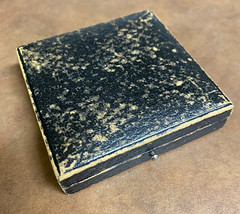 A Newman Portal user forwarded images of a medal awarded at the Deadwood Fair by the Black Hills Fair Association. The example was awarded to our correspondent's gr-gr-grandfather, Elisa Pauli, in 1908. The award inscription is crude and not as finely done as usually seen on eastern medals.
A Newman Portal user forwarded images of a medal awarded at the Deadwood Fair by the Black Hills Fair Association. The example was awarded to our correspondent's gr-gr-grandfather, Elisa Pauli, in 1908. The award inscription is crude and not as finely done as usually seen on eastern medals.
The Alan Weinberg collection contains an unawarded example, of which Alan writes White metal. I usually do not put white metal items in my collection, preferring only silver or gold. But this is a territorial Dakota medal, made of Black Hills tin, is extremely rare (I've seen only two), Gem Proof and in an original case of issue - just too much for me to ignore.
We found nothing related to the Deadwood Fair or the Black Hills Fair Association in the usual places; this was likely an agricultural and mechanical fair similar to other such events at the time. Perhaps E-Sylum readers might have additional information?
Images: Deadwood Fair award medal issued to Elisa Pauli in 1908.
Links to Weinberg example on NNP:
https://nnp.wustl.edu/library/ImageDetail/510828
https://nnp.wustl.edu/library/imagedetail/510829
VIDEO: GLENN SMEDLEY
The David Lisot Video Library on the Newman Numismatic Portal can be found at:
https://nnp.wustl.edu/library/multimediadetail/522852
We highlight one of his videos each week in The E-Sylum. Here's one from 1986 with ANA stalwart Glenn Smedley. -Editor
David Lisot interviews Glenn Smedley of the American Numismatic Association who collected Victor David Brenner medals and wrote "Numismatic Vignettes" for the ANA publication "The Numismatist."
Glenn was involved in numismatics for over 50 years, spending 18 years on the ANA Board of Governors. He wrote the "Numismatic Vignettes" column in The Numismatist and had many world-class collections, including medals by Victor David Brenner. He had met dealer B. Max Mehl and became friendly with Amon Carter, Abe Kosoff, and countless other numismatic personalities of his era.
I spent a nice afternoon at ANA headquarters in 1984 where Glenn kindly gave me a tour of the building, all while rolling an oxygen tank behind him. He was very gracious in hosting a numismatic newbie. David interviewed Smedley at his home in Colorado Springs. -Editor
To watch the complete video, see:
https://nnp.wustl.edu/library/book/584164
MORE ON COIN POSTCARD ALBUMS
Readers had a number of comments on coin postcard albums. -Editor
David Gladfelter writes:
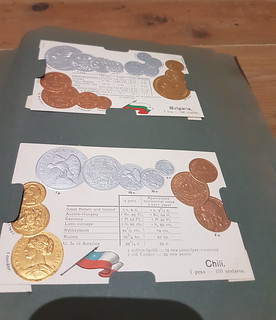 "Ms. Davies's set of 45 cards appears to contain cards of substantially the same countries as those published circa 1910 by printers and compilers in Germany and Austria for the tourist market. The cards were sold singly and in sets, and the sets could be obtained in folders, loose leaf albums (like Ms. Davies's) and in bound books. I have not seen the particular album variety that Ms. Davies has and hope that her album might have some indication of the source. The brochure is very similar to those in other albums (and folders and bound books) produced at the time.
"Ms. Davies's set of 45 cards appears to contain cards of substantially the same countries as those published circa 1910 by printers and compilers in Germany and Austria for the tourist market. The cards were sold singly and in sets, and the sets could be obtained in folders, loose leaf albums (like Ms. Davies's) and in bound books. I have not seen the particular album variety that Ms. Davies has and hope that her album might have some indication of the source. The brochure is very similar to those in other albums (and folders and bound books) produced at the time.
"I wrote stories about these coin cards and collections in The Asylum in 2005 and 2006 that can be found on the Newman Numismatic Portal. Since then, quite a bit has been discovered about them. Thomas Engelen of Lenzerheide, Canton Graubunden, Switzerland, has been working on a very detailed catalog of these cards for a number of years and I will make sure to inform him of this discovery. Hans-Joachim Bergmann of Herbrechtingen, Germany, is another coin-card expert and a dear friend.
"The card of Canada, as you will see by looking at the dates on the coins, was published much later, circa 1925. By then a new publisher had taken over the business and had expanded the line (and of course many new countries came into being after World War I).
"I can't explain the asking price for this card, except perhaps that some Canadian collectors must be gung ho or something. The last of the cards came out right before World War II, circa 1937."
From snowy Swiss mountains, Thomas Engelen writes:
"The album in question was made to host cambist cards for the UK market, most likely the album produced in the UK itself. The copy I have has a mixed content re publishers of cards just like the one Mrs Davies seems to have including three cards made by HSM for Boots The Chemists, UK. My album has the original price tag of 2/6
, or two Shilling and Sixpence
. The leaflet included is an accurate translation of the text on leaflets found in German language albums by Heimbrecht (Germany) and Blümel (Austria).
"All cards that have a text – headings are in English, country-indications (mostly bottom right) in English, as are the currency exchange rate tables. Even if from different German publishers all clearly collected to serve an English-speaking audience......From the cards & countries included it is clear these albums were made pre-WWI / pre 1914.
"Canadian cambrist cards : enclosed two pages of my draft coin cards listing. The listing was put together with the help of David Gladfelter and Hans Bergmann (Germany).
"These Canadian cards are not very rare: for none of the 4 varieties listed, nor for three duplicates I have I paid more than $25 /each, one of these I bought last December via eBay from a Canadian collector. I've seen the $375 card listed, it was listed before at $600 and – guess what – it's still to be had. In my years of collecting the highest paid price I've seen is $185 for an Egyptian card with two bidders from Egypt."
Alan Roy writes:
"Sally T Davies asks why the Canadian coin postcard is so valuable compared to the other coin postcards in her album. I have one of the Canadian cards in my collection that I gladly paid three figures for. It is in high demand because of the coins portrayed on it. The 1921 5-cent and 50-cent coins are exceptionally rare and among the most valuable coins in the decimal series. The 1911 dollar was a pattern and never issued for circulation. Only three exist: one in lead and two in silver. It has for years been by far the most valuable Canadian coin. The only one in the collector hands was recently donated to the National Currency Collection, which now is in possession of all three examples.
This is as close as I'll get to owning these coins."
"I'm very happy to hear that there's such erudite interest in the album. There are no indications on the album as to it's origin though I strongly suspect it's German or Austrian, incidentally, a Google search brought up an identical one with the title in French. Some of the cards are stamped H.S.M for Hugo Semmler and some are stamped dep. with a number.
"Although they appear relatively rarely I suspect there are quite a few of these albums lingering in drawers and attics, perhaps more will emerge in time"
To read the earlier E-Sylum article, see:
A COIN POSTCARD ALBUM
(https://www.coinbooks.org/v26/esylum_v26n09a13.html)
NOTES FROM E-SYLUM READERS: MARCH 5, 2023
Remembering Kay Edgerton Lenker
Ginny Bourke submitted these thoughts on the recent passing of San Diego native Kay Edgerton Lenker. -Editor
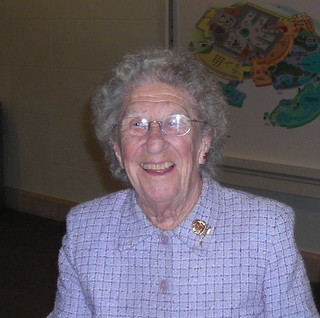 Catharine Edgerton Lenker (Kay) was born on November 29, 1922 in
Philadelphia and joined the Navy as a meteorologist in 1945 serving in active
duty from 1944 to 1954. She retired from the Naval Reserves with the rank
of Captain and used that in her e-mail address. She became interested in
coins in 1955. Kay was a remarkable woman who contributed over 250
service years (Joe Boling figured that out!) to numismatics.
Catharine Edgerton Lenker (Kay) was born on November 29, 1922 in
Philadelphia and joined the Navy as a meteorologist in 1945 serving in active
duty from 1944 to 1954. She retired from the Naval Reserves with the rank
of Captain and used that in her e-mail address. She became interested in
coins in 1955. Kay was a remarkable woman who contributed over 250
service years (Joe Boling figured that out!) to numismatics.
I met Kay and husband Stuart in Oceanside, California at a joint meeting of the San Diego County Inter-Club Numismatic Council where they were selling some of their coins. An avid exhibitor, Kay always had at least 2 or 3 exhibits whenever she could bring an exhibit and more often than not, took a best-of-show or first place ribbon. I will never forget when she exhibited an 1895 proof set at the Del Mar Fair in San Diego County with its limited security.
She was always working on behalf of the hobby and volunteered to serve as an officer in too many organizations to count. She served 2 terms as Governor for the ANA. She edited the SDCICNC bulletin for over 50 years which was mailed to every member of every Council club. She turned 100 in November and was staying in an assisted living facility where she caught a cold that turned into pneumonia which she succumbed to in February, 2023. She had previously been given the 2022 ANA Elvira-Clain Stefanelli Memorial Award of which she proudly showed off to all her visitors.
She had so many friends in the world and was a member of the group of
travelers who circumnavigated the world. We in San Diego were so blessed when
Kay and Stuart decided to live in San Diego, California. Ken Spindler has
sponsored the best-of-show
plate dedicated to Kay and is going on his
second plate.
RIP our friend and mentor; you leave us heartbroken but very glad that you were always there for us.
To read earlier E-Sylum articles, see:
HAPPY 100TH BIRTHDAY, KAY LENKER!
(https://www.coinbooks.org/v25/esylum_v25n49a20.html)
KAY EDGERTON LENKER (1922-2023)
(https://www.coinbooks.org/v26/esylum_v26n08a03.html)
Making a Chainmail Dress from Pennies
Remember the chainmail dress made from Lincoln cents? Kavan Ratnatunga passed along Facebook videos of the dress being made. Thanks! -Editor
To watch the videos, see:
Making a chainmail dress out of pennies- part 1!
(https://www.facebook.com/crescentshaycos/videos/742952853716584)
sewing 2000+ pennies into a chainmail dress- part 2!
(https://www.facebook.com/crescentshaycos/videos/622465952980550)
To read the earlier E-Sylum article, see:
THE DRESS MADE FROM PENNIES
(https://www.coinbooks.org/v25/esylum_v25n06a30.html)
W. S. Baker's Book on William Sharp
Len Augsburger of the Newman Numismatic Portal reports that a copy of W. S. Baker's 1875 book, William Sharp, Engraver has been added to NNP. -Editor
To read the book on NNP, see:
William Sharp, engraver : with a descriptive catalogue of his works
(https://nnp.wustl.edu/library/book/623934)
More on Allen Nystrom
Eric Holcomb writes:
"Al Nystrom was Pacific Northwest Numismatic Association Honorary Life Member 16, and his wife Nina was also a longtime member. Both are listed on the PNNA memorial page.
"The PNNA's Nina Nystrom Memorial Goodwill Ambassador Award was renamed after Nina (the award's first recipient in 1990) after Nina passed away later in the 1990s. We hope to have another Nystrom award recipient this year, after not having one for 2021-2022."
That's great to hear. -Editor
For more information, see:
https://www.pnna.org/wp/info/pnna-history/memorial/
https://www.pnna.org/wp/awards/nystrom-award/nystrom-winners/
To read the earlier E-Sylum article, see:
ALLEN NYSTROM (1909-2009)
(https://www.coinbooks.org/v26/esylum_v26n09a19.html)
Another Cut Down Large Cent
David Luftig writes:
"I also have a cut down large cent. Slightly bigger than a nickel. Acquired in a junk box sometime somewhere. No idea as to what the purpose was."
Thanks. Another numismatic mystery. -Editor
To read the earlier E-Sylum article, see:
WAYNE'S NUMISMATIC DIARY: FEBRUARY 26, 2023, PART 1 : Cut Down Large Cents
(https://www.coinbooks.org/v26/esylum_v26n09a28.html)
Crushing Snowfall in Crestline
NBS co-founder George Kolbe of Crestline writes:
"I thought Big E subscribers might like to see an unusual view of Southern California. This is from the front of our home. Actually, only the garage is visible due to the snow build up. The roof of the only supermarket in town, Goodwins, collapsed earlier."
Whoa - that's a lot of snow! George reports that their power has been out since Tuesday night. Below is a newspaper photo of the supermarket followed by George's great photo of the sunset over L.A. -Editor
To read the complete article, see:
Snow collapses roof of Goodwin and Sons, Crestline's only grocery store
(https://www.sbsun.com/2023/03/02/snow-collapses-roof-of-goodwin-and-sons-crestlines-only-grocery/)
With great views come great natural disasters, it seems. Back in 2003 we published three special issues reporting that George and his wife Linda had been evacuated from their Crestline home due to massive forest fires in the area. Luckily, their home and the John J. Ford library George had been cataloging for sale were spared. -Editor
Tonight, George adds:
"We are warm and well-fed. The main roads are still mostly closed and we remain snowbound (a crew is scheduled to dig us out later today). Municipal power is off but our home generator is working.
"The storm produced the most snow in fifty years in our local San Bernardino Mountains (six to ten feet), in an area stretching over thirty miles, with tens of thousands of homes and cabins. Other mountains in the area have been similarly impacted. Despite the fires and snow, we love living here."
To read the earlier E-Sylum articles, see:
KOLBES EVACUATED FROM CRESTLINE FIRE ZONE
(https://www.coinbooks.org/esylum_v06n44a01.html)
KOLBE UPDATE
(https://www.coinbooks.org/club_nbs_esylum_v06n45.html)
KOLBE UPDATE: GOOD NEWS!!
(https://www.coinbooks.org/club_nbs_esylum_v06n46.html)
KOLBE UPDATE: STILL NO POWER, BUT PROPERTY SAFE
(https://www.coinbooks.org/esylum_v06n47a02.html)
ANS LIBRARY INTERNS WELCOMED
The March 2023 issue of ANS eNews from the American Numismatic Society welcomes two new library interns. -Editor
The ANS Welcomed Two Library Interns
We are pleased to welcome two new interns to the library, Jennifer Jenkins and St John Karp. Jennifer, who expects to complete her library degree at the Palmer School this year, with a concentration in rare books, special collections, and archives, has over a decade's experience as an editor with financial and auction firms.
St John's background is in computer programming and systems administration. In addition to working toward his library degree at Pratt Institute, which he expects to finish next year, St John holds a part-time position with the New York Public Library for the Performing Arts. Jennifer and St John have been helping us at the ANS and gaining valuable experience by cataloging some of our old and new books, auction catalogs, and articles.
For more information, see:
The Harry W. Bass Jr. Library
(https://numismatics.org/basslibrary/)
THE BOOK BAZARRE
Bowers Serieswas written by award-winning author Joshua McMorrow-Hernandez, who presents these silver coins to both collectors and investors. 384 pages. Order your copy online at Whitman.com , or call 1-800-546-2995.
RCNA LIBRARY MOVING TO NICKLE GALLERIES
Royal Canadian Numismatic Association's library is moving to Nickle Galleries in Calgary. Here's a report from Canadian Coin News. -Editor
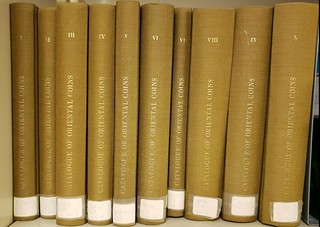 The Royal Canadian Numismatic Association (RCNA) has announced the sale of its library to the Nickle Galleries, a museum and art gallery housed at the University of Calgary.
The Royal Canadian Numismatic Association (RCNA) has announced the sale of its library to the Nickle Galleries, a museum and art gallery housed at the University of Calgary.
Home to what its curators called one of the most important numismatic collections in Canada,
the Nickle Galleries (formerly known as the Nickle Arts Museum) also displays contemporary art with a focus on Western Canada plus an extensive textile collection. The RCNA library will join the Nickle Galleries' numismatic collection.
Once staff finishes cataloguing the library's contents on the university system, its material will be available to everyone – both RCNA members and the general public – to borrow through an inter-library loan via their local library. Visitors to the Calgary museum can also view the material in person.
The RCNA will soon announce via its website and bimonthly journal details about when and how the material can be accessed.
The Nickle Galleries' numismatic collection spans 23,000 artifacts from the beginning of coinage in the seventh century BCE through the present day.
In 2019, the museum hosted a fundraising banquet plus an exhibition, Money and Calgary: The City's History of Numismatics,
at that year's RCNA Convention in Calgary.
To read the complete article, see:
RCNA library moving to Calgary
(https://canadiancoinnews.com/rcna-library-moving-to-calgary/)
For more information on Nickle Galleries, see:
https://nickle.ucalgary.ca/
To read some earlier E-Sylum articles, see:
NICKLE GALLERIES: COINS OF JESUS EXHIBIT
(https://www.coinbooks.org/v20/esylum_v20n34a24.html)
CALGARY NICKLE GALLERIES WHAT IS MONEY? EXHIBIT
(https://www.coinbooks.org/v21/esylum_v21n20a29.html)
NICKLE GALLERIES EXHIBIT: MONEY AND CALGARY
(https://www.coinbooks.org/v22/esylum_v22n23a21.html)
EXHIBIT: BIRTH OF PORTRAITURE: ALEXANDER THE GREAT
The latest numismatic Nickle Galleries exhibit focuses on the coinage of Alexander the Great and his successors. -Editor
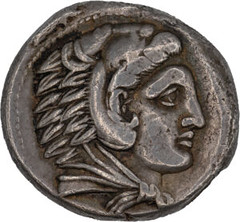 Drawing on the rich holdings of the Nickle Numismatic collection, curator Marina Fischer explores the life of Alexander the Great and his successors through their portraits on ancient coins. Tiny masterpieces of Hellenistic art, these ancient coins record likenesses and suggest the distinctive personality of their subject's.
Drawing on the rich holdings of the Nickle Numismatic collection, curator Marina Fischer explores the life of Alexander the Great and his successors through their portraits on ancient coins. Tiny masterpieces of Hellenistic art, these ancient coins record likenesses and suggest the distinctive personality of their subject's.
A portrait is typically defined as a representation of a specific individual. It does not merely record someone's features, but says something about their character and personality, offering a vivid sense of a real person's presence.
The Birth of Portraiture: Alexander the Great & His Successors exhibition explores the life of Alexander the Great, his friends and generals who succeeded him after his death, and the later Indo-Greek Kings in Asia between the 3rd and 1st centuries BCE – through their portraits on ancient coins, the unprecedented realistic representations of the human likeness.
The tradition of portraiture in the West extends back to antiquity and particularly to the Hellenistic period (323-30 BCE), where lifelike depictions of distinguished men and women appeared on coins. After many centuries in which cold, idealized, generic representations had been the norm, distinctive portrait likenesses began to appear at end of the 4th century and the early 3rd century BCE, starting with Alexander the Great (356-323 BCE). This change reflected a new growth of interest in everyday life and individual identity as well as distinctiveness.
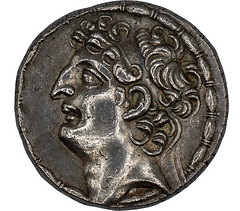 The portraiture of the ruler was an effective and persuasive means of projecting the qualities of the monarch. This style, expressed in the serene images of the king, is intended to perpetuate the transcended human limitations of the otherwise mortal ruler. These portraits are masterpieces of Hellenistic art, depicting in fine detail not only the person's features about whom we often know so little, but also indications of how they are intended to be seen.
The portraiture of the ruler was an effective and persuasive means of projecting the qualities of the monarch. This style, expressed in the serene images of the king, is intended to perpetuate the transcended human limitations of the otherwise mortal ruler. These portraits are masterpieces of Hellenistic art, depicting in fine detail not only the person's features about whom we often know so little, but also indications of how they are intended to be seen.
In antiquity, the portraits functioned just as images in the popular culture today. Our relatively recent obsession with selfies, the self-portraits posted on social media, has the same origin as the Hellenistic coin portraits, which function as a self-study with the aim of a better understanding of oneself.
Curated by Marina Fischer.
For more information, see:
The Birth of Portraiture: Alexander The Great and His Successors
February 2, 2023 - April 30, 2023
(https://nickle.ucalgary.ca/exhibition/upcoming-the-birth-of-portraiture-alexander-the-great-and-his-successors/)
NEW FRACTIONAL CURRENCY FACEBOOK PAGE
The Fractional Currency Collectors Board (FCCB) has added a new Facebook page. Thanks to Steve Shupe for passing along this announcement. -Editor
Join The NEW F.C.C.B. Facebook Group today!
Why should you join our Facebook group?
- Communicate with other FCCB'ers
- Share a new purchase
- See what others are collecting
- Trade with other collectors, find something that you have been hunting for
- Have a question/give an answer. Share knowledge with other collectors
- Sell an extra fractional note that you may have upgraded
- Get expert opinions (and even not so expert opinions ?)
- Make friends with other collectors
- Learn how to take pictures, make a registry set, know what to look for, know what to look out for, learn how to evaluate a note, learn how to store a note and much more…
- Going to a show? Meet up with other fractional collectors
Very simple to join. Once you have logged into Facebook;
To visit the FCCB Facebook page, see:
https://www.facebook.com/groups/668778831695737
VOCABULARY TERMS: MINTMASTER'S MARK AND MORE
Here's a collection of short entries from Dick Johnson's Encyclopedia of Coin and Medal Terminology. -Editor
Mintmaster's Mark. The signature, usually the initial, of the chief official of a mint, infrequently found on coins and medals. Such personal signatures were in addition to that of the die engraver, or mintmark (often two such marks would appear on the same coin, rarely three, as this did lead to some confusion). A modern example is the precious metal products of the jewelry firm of Tiffany & Co., where, since 1880, all items were signed with the last initial of the president's name (M for Edward C. Moore, P for Henry B. Platt, and such). In a way, it meant the president guaranteed the quality of the piece that bore his initial much like that of a mintmaster's mark.
To read the complete entry on the Newman Numismatic Portal, see:
Mintmaster's Mark
(https://nnp.wustl.edu/library/dictionarydetail/517199)
Mirror Image. Matching opposite polarity; a reflected image. Struck pieces are a mirror image of their dies; dies are a mirror image of their hub or patrix. Positive and negative plaster casts are mirror images of each other. A mirror image is called contraposition. The congruent interface surfaces of two-part medals are often mirror images of each other. Compare retrograde lettering.
To read the complete entry on the Newman Numismatic Portal, see:
Mirror Image
(https://nnp.wustl.edu/library/dictionarydetail/516334)
Misaligned Die. A striking error from one or both dies not seated properly during setup, or working loose (chattering) during striking. There are two kinds of misaligned dies: (1) vertical – where the dies strike pieces one side of which is off center while the other side is perfect, and (2) horizontal – in which the dies are tipped causing them to strike wedge shaped pieces. The latter pieces lack parallelism. When dies are made it is required that the top and bottom are absolutely parallel. When they are placed in a press this parallelism is required as well. Dies tipped at any stage of their manufacture or use will result in misaligned error strikes. Collectors have abbreviated this term as MAD.
Reference:
NM19 {1991} Margolis, p 293-295.
To read the complete entry on the Newman Numismatic Portal, see:
Misaligned Die
(https://nnp.wustl.edu/library/dictionarydetail/516337)
CORNELIUS CLARKSON VERMEULE III (1925-2008)
E-Sylum Feature Writer and American Numismatic Biographies author Pete Smith submitted this article on author Cornelius Vermeule. Thanks! -Editor
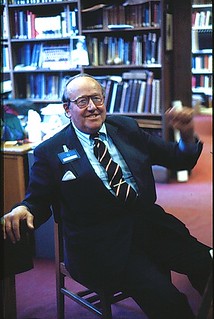 Cornelius Vermeule was known to share his opinions about the artistic merit of American coins. In describing the 1792 half disme, he wrote,
Cornelius Vermeule was known to share his opinions about the artistic merit of American coins. In describing the 1792 half disme, he wrote, The eagle on the reverse is an ailing barnyard fowl, with undersized wings spread at odd angles, curving neck, and oddly foreshortened body, a creature nowhere better seen that on the small surfaces of the dime and half disme.
He was born in South Orange, New Jersey, on August 10, 1925. His father, Cornelius Vermeule II (1895-1943) was distinguished as a major during the first world war and served as Director of Public Works Administration in New Jersey. His Mother was Catherine Sayre Comstock (1894-1996).
While in England in 1934, he began to collect ancient coins. Both his father and grandfather collected coins and their collections were passed down to him. Before going to college, Vermeule worked at Stack's on 57th Street in New York He was not paid in cash but in ancient Roman coins.
Vermeule entered Harvard in 1943 but his education was interrupted with service in the Army during the war. He studied Japanese and stayed in Japan for a while after the war ended and attained the rank of Captain. Back at Harvard, he received an A.B. in 1949 and M.A. in 1951. He received a Ph.D. from the University of London in 1953. While in London he assembled much of his collection of Roman Imperial bronze coins. The American Numismatic Society in New York City attempted to promote young numismatic scholars. In 1951 they offered a $100 prize for the best paper on numismatics. The winner was Cornelius Clarkson Vermeule III.
He collaborated with Norman Jacobs to write Japanese Coinage in 1953. It was published by Stack's Numismatic Review. It was followed by Modern Japanese and Chinese Coinage in the British Museum
in two parts.
His first professional job was teaching fine arts at the University of Michigan from 1953 to 1955. Then he was professor of archaeology at Bryn Mawr College until 1957.
Cornelius married Emily Dickinson Townsend (1928-2001) on February 2, 1957. She had been a Bryn Mawr student who graduated summa cum laude in 1950, received a masters degree from Radcliff in 1954 and returned to Bryn Mawr for her Ph.D. in 1956. She was later a professor at Harvard. The couple enjoyed going on archeological digs together. Their daughter Emily Dickinson Blake Vermeule. is a professor of English at Stanford University. Their son, Adrian Vermeule, is a professor at Harvard Law School.
Also in 1957, Vermeule contributed to the coin room at Harvard's Fogg Museum. The museum may be remembered for an armed robbery of 3000 coins in 1973. It was described at the time as the largest coin theft in American history.
Later in 1957 Cornelius was appointed curator of classical collections at the Museum of Fine Arts on Huntington Avenue in Boston. He arranged for the acquisition of two large Greek vases from the fifth century BCE portraying the fall of Troy and the death of Agamemnon. When director Rathbone was forced to resign because of the acquisition of a stolen Raphael, Vermeule served as acting director of the museum. Late in his career he was also involved in the acquisition without documentation of possibly looted antiquities. He retired in 1996.
He wrote Numismatic Art in America: Aesthetics of the United States Coinage in 1971. It grew out of a series of lectures Vermeule made a few years earlier. A second edition published in 2007 describes more recent coins including the state quarters.
Vermeule was known as a prankster and joker in several languages. He brought his dalmatians, named after classical Romans to work. Along that theme of dalmatians, he wore white shoes painted with black dots around the museum. He described them as the only pieces of modern art to appear in all rooms of the museum.
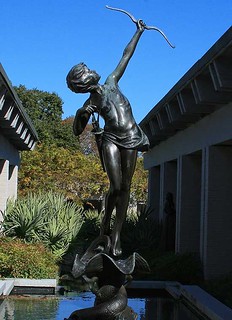 In 1982 the art world was intrigued by comments from Bette Davis that she had posed nude for a woman artist when she was eighteen in 1924. The search was on and Cornelius Vermeule discovered a sculpture of Diana by Anna Hyatt Huntington that fit the description. It was stored out of sight in a back room at the Boston Museum.
In 1982 the art world was intrigued by comments from Bette Davis that she had posed nude for a woman artist when she was eighteen in 1924. The search was on and Cornelius Vermeule discovered a sculpture of Diana by Anna Hyatt Huntington that fit the description. It was stored out of sight in a back room at the Boston Museum.
Vermeule's collection of roman coins was offered in a mail bid sale by Classical Numismatic Group on June 23, 1999. It was sold for the benefit of the classical department of the Boston Museum of Fine Arts. His Roman Imperial Republican and Imperatorial Gold were included in the Triton III sale of November 30 and December 1, 1999.
Stack's published a catalog for the sale of his remaining collection at auction on September 11, 2001. The sale was postponed until November 12-13. The write up for Vermeule included some useful biographical information with a fair amount of hype for the auction company.
Vermeule was a lifetime fellow at the American Numismatic Society, served on the council and served on committees. He died following a stroke at Mount Auburn Hospital in Cambridge, Massachusetts, on November 27, 2008.
I did not mention Vermeule in a recent article I wrote about Fake Names in Numismatics.
Vermeule used the pseudonyms Wentworth Bunsen, Northwold Nuffler, and Isao Tsukinabe.
This was a frustrating article to research. I spent more hours looking for what I could not find than hours that were productive. I wanted to know the connection between Emily Dickinson Townsend and the poet Emily Dickinson. I could not find a common ancestor. I also read that Anna Hyatt Huntington was the great step-aunt of Vermeule. I could not make that connection.
If I can find the time next week, I want to write about the most wealthy American woman in the Gilded Age.
For more information on Huntington's Young Diana
, see:
Anna Hyatt Huntington - Young Diana
(https://www.pinterest.com/pin/608126755907698047/)
Anna Hyatt Huntington's 1924 bronze statue, "The Young Diana," outside the open-air sculpture gallery at Brookgreen Gardens, a vast complex of sculpture gardens, ecosystem trails, a wildlife preserve and a small zoo on four former rice plantations in Murrells Inlet, South Carolina
(https://www.loc.gov/item/2017881059/)
Call Box: Does Cummer's 'Diana' statue have Bette Davis eyes?
(https://www.jacksonville.com/story/news/reason/call-box/2017/12/01/call-box-does-cummer-s-diana-statue-have-bette-davis-eyes/15363029007/)
To read earlier E-Sylum articles, see:
WHITMAN TO PUBLISH UPDATE OF VERMEULE'S 'NUMISMATIC ART IN AMERICA'
(https://www.coinbooks.org/esylum_v10n14a09.html)
CORNELIUS VERMEULE 1925-2008
(https://coinbooks.org/esylum_v11n50a09.html)
MORE ON CORNELIUS C. VERMEULE
(https://www.coinbooks.org/esylum_v11n51a10.html)
MORE ON CORNELIUS VERMEULE
(https://www.coinbooks.org/esylum_v11n52a05.html)
VERMEULE AND JACOBS AND THE BANK OF JAPAN
(https://www.coinbooks.org/esylum_v15n20a14.html)
2023 COIN WORLD MOST INFLUENTIAL VOTING
The polls are now open for voting in Coin World's 2023 Most Influential People in Numismatics issue. -Editor
From Coin World's email announcement to readers:
"In 2021, we polled the numismatic community to determine the Most Influential People in Numismatics for the first time.
"And we were blown away by the feedback, interaction and buzz this simple activity generated.
"Now an annual tradition, we once again turn to you to express your opinion: who are the Most Influential People in Numismatics?
"Voting ends March 15th!
"Your ballots will influence the selection of giants within the hobby who will be profiled in the upcoming publication Coin World 2023 Most Influential People in Numismatics.
"This publication, free to all Coin World magazine subscribers, will be published alongside the May 2023 issue of the magazine. Afterwards, additional copies may be purchased from Coinworld.com in limited quantities, while supplies last."
To vote:
https://coinworld.com/2023mi
I was pleased to see some new names on the ballot this year, and there is also a write-in option. Remember, the candidates must be living. E-Sylum readers will recognize quite a number of names - our contributors, advertising supporters and NBS officers are a who's who of our hobby, and all deserving of recognition. If you intend to vote and haven't yet, please take a couple minutes and do it now. It's a very quick process. -Editor
NEIL SHAFER MILITARY NUMISMATICS AWARD
The Military Numismatics National Champion Award has been renamed in honor of author and researcher Neil Shafer. -Editor
MPC Fest announces new name of annual National Champion award
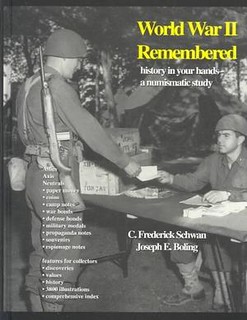 For over twenty years collectors of military currency and related objects have eagerly awaited
the announcement of the winner of the annual National Championship competition held at MPC
Fest. Each night of Fest attendees are matched against each other in a brackets-style competition
testing their knowledge of military numismatics, including contents of
For over twenty years collectors of military currency and related objects have eagerly awaited
the announcement of the winner of the annual National Championship competition held at MPC
Fest. Each night of Fest attendees are matched against each other in a brackets-style competition
testing their knowledge of military numismatics, including contents of The Book
(World War
Two Remembered: History in Your Hands, also known as Schwan-Boling) as well as material
discovered through subsequent research. Each winner receives the title National Champion, and
a silver Fest challenge coin of the year engraved Champion.
Notable three-time winners
include Neil Shafer, Jim Downey, Bill Myers, and Fred Schwan. By tradition these four have
retired from the competition, to give aspiring contenders a chance at winning! This hard-earned
award has never had a formal name, but this year, that will change.
MPC Fest, to honor one of our senior knowledge-bearers and sharers, and to celebrate the return
to an in-person event after three years away, is deeply pleased to announce the naming of the
award the Neil Shafer Military Numismatics National Champion Award.
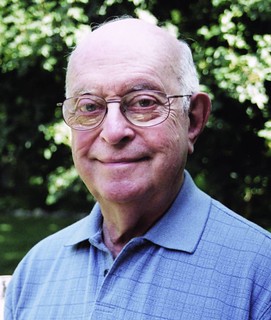 A beloved and
respected member of the Fest community and the wider numismatic world, Mr. Shafer's
influence on the hobby cannot be overstated. His life is full of fascinating stories and his
biography would fill many pages, but here are a few highlights. He has been an active collector
and numismatist since the 1940s. He is a recipient of the ANA's Farran Zerbe Memorial Award
for Distinguished Service in 2014, and the NLG Clemy Award in 2004, among other awards too
numerous to list. He is a life member of many numismatic organizations including ANA, IBNS
(and an early inductee to the IBNS Hall of Fame), SPMC, Philippine Numismatic and
Antiquarian Society, many local and state clubs, and—for 20 plus years— a member of MPC
Fest. A true educator and evangelist for numismatists, Mr. Shafer has written for every major
publication, many smaller and local publications, has taught at ANA Summer Seminar, and has
made presentations at an uncountable assortment of organizations, including over fifteen staff
briefings at MPC Fest.
A beloved and
respected member of the Fest community and the wider numismatic world, Mr. Shafer's
influence on the hobby cannot be overstated. His life is full of fascinating stories and his
biography would fill many pages, but here are a few highlights. He has been an active collector
and numismatist since the 1940s. He is a recipient of the ANA's Farran Zerbe Memorial Award
for Distinguished Service in 2014, and the NLG Clemy Award in 2004, among other awards too
numerous to list. He is a life member of many numismatic organizations including ANA, IBNS
(and an early inductee to the IBNS Hall of Fame), SPMC, Philippine Numismatic and
Antiquarian Society, many local and state clubs, and—for 20 plus years— a member of MPC
Fest. A true educator and evangelist for numismatists, Mr. Shafer has written for every major
publication, many smaller and local publications, has taught at ANA Summer Seminar, and has
made presentations at an uncountable assortment of organizations, including over fifteen staff
briefings at MPC Fest.
He served in the USAF, as a violist in the USAF Symphony Orchestra,
from 1955 to 1959. Mr. Shafer is also famous throughout the MPC and wider numismatic
communities for his little black bag,
which accompanies him at all times. From this bag he
extracts just exactly the one collectible that you had not realized you needed, had not budgeted
for, but which you absolutely HAD to acquire before he could offer it to someone else!
As always, this year's Fest, Fest 24, will be held at Camp Leo May, Port Clinton, Ohio (Port
Clinton-Catawba Island Holiday Inn Express), from March 16th to March 19th. The keynote
speaker will be Thomas J. Sparks, speaking on The Short Snorter of Major General Clayton
Lawrence Bissell, U.S. Army Air Service.
Register by calling 419-732-7322. And watch this
and other numismatic publications for announcement of this year's winner, the first to be
awarded the Neil Shafer Military Numismatics National Champion Award!
To read the earlier E-Sylum article, see:
2018 SPMC Hall of Fame Inductees
(https://www.spmc.org/hall-of-fame?field_induction_year_value%5Bvalue%5D%5Byear%5D=2018)
To read earlier E-Sylum articles, see:
SHAFER WINS NLG'S "CLEMMY"
(https://www.coinbooks.org/esylum_v07n36a05.html)
NEIL SHAFER'S 'MONEY OF THE PEOPLE' COLLECTION
(https://www.coinbooks.org/esylum_v17n20a32.html)
SHORT SNORTER EXHIBIT COMING TO PHOENIX
(https://www.coinbooks.org/v26/esylum_v26n06a26.html)
PNG 2023 YN SCHOLARSHIP COMPETITION
The PNG recently announced its 2023 YN Scholarship Competition. Here's the press release. -Editor
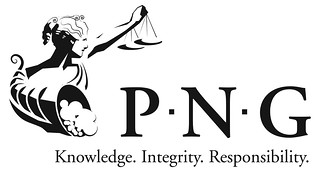 For the first time since the COVID pandemic began in 2020, the Professional Numismatists Guild (www.PNGdealers.org) will provide a scholarship to a deserving young numismatist (YN) to attend one of the six-day sessions of the American Numismatic Association (www.money.org) Summer Seminar in Colorado Springs, Colorado.
For the first time since the COVID pandemic began in 2020, the Professional Numismatists Guild (www.PNGdealers.org) will provide a scholarship to a deserving young numismatist (YN) to attend one of the six-day sessions of the American Numismatic Association (www.money.org) Summer Seminar in Colorado Springs, Colorado.
Now that the pandemic has subsided and the ANA is back to its full Summer Seminar programming this year, we are delighted to resume our long tradition of providing a YN scholarship for the popular, annual ANA educational programs. The PNG scholarship will cover airfare, tuition for one of the two 2023 Summer Seminar sessions, meals, and five nights of dormitory accommodations on the campus of Colorado College, the site of the ANA headquarters,
said PNG Executive Director Robert Brueggeman.
All young numismatists between the ages of 13 and 22 are eligible to enter and are cordially invited to apply for the scholarship, but time is short. Entrants must submit a short essay outlining why they should be chosen as this year's scholarship recipient. The deadline for receipt of the entries is Friday, March 31, 2023,
explained Brueggeman.
Entries must include the applicant's name and contact information. The essays can be sent by email to info@PNGdealers.org or by mail to the PNG Executive Director, 28441 Rancho California Road, Suite 106, Temecula, CA 92590.
The two separate ANA Summer Seminar six-day sessions will be held from Saturday, June 17, to Thursday, June 22, and from Saturday, June 24, to Thursday, June 29, 2023. Participants ranging from teenagers to seniors take class instruction on specific coin and paper money collecting topics or the hobby's technical and business aspects. Additional information about the ANA Summer Seminar can be found on the ANA website at www.money.org/summer-seminar/register.
The PNG is a nonprofit organization composed of many of the top rare coin and paper money dealers in the United States and four other countries. PNG member-dealers must adhere to a strict Code of Ethics in the buying and selling of numismatic merchandise. For additional information about PNG or the young numismatists scholarship program, visit online at www.PNGdealers.org or call (951) 587-587-8300.
STACK'S BOWERS PROFESSIONAL NUMISMATIST PROGRAM
Stack's Bowers is launching a Professional Numismatist Program. The coin industry always needs fresh young talent. Other auction and grading firms have internship programs as well, and these are great follow-ons to events like the American Numismatic Association's Summer Seminar and Witter Coin University. Good luck to all who apply. -Editor
Stack's Bowers Galleries is launching a Professional Numismatist Program (PNP). This program is geared toward aspiring numismatists ages 18-25. The first one-week seminar is scheduled from July 30 to August 5, 2023 at our global headquarters in Costa Mesa, California.
PNP is fully funded by Stack's Bowers Galleries, including transportation, accommodation, meals and entertainment. Classes will be taught by our unparalleled team of numismatists.
Core curriculum will feature advance coin grading, numismatic wholesale trading and valuation, bullion trading and world and ancient numismatics. We will also be offering several elective courses such as auction cataloging, marketing, paper money, photography and auctioneering. If you are interested in taking advantage of this wonderful opportunity, please submit your application by May 1, 2023.
To read the complete article, see:
STACK'S BOWERS GALLERIES PROFESSIONAL NUMISMATIST PROGRAM
(https://stacksbowers.com/stacks-bowers-galleries-professional-numismatist-program/)
NUMISMAGRAM MEDAL SELECTIONS: MARCH 3, 2023
Jeremy Bostwick at Numismagram forwarded these three highlights from his recent upload of new material to his website. As may be indicated by these selections, the upload focuses heavily upon architectural themes in exonumia—especially the popular cathedral series of Jacques Wiener and his brothers. For all of the new items, please visit https://www.numismagram.com/inventory. -Editor
102314 | ITALY. Vatican City. St. Peter's Basilica silvered bronze Medal. Issued 1857. Most Remarkable Edifices of Europe series (60mm, 94.93 g, 12h). By J. Wiener in Brussels and struck at the Geerts mint in Ixelles. BASILICA DI S. PIETRO A ROMA, perspective view of the eastern façade of the exterior of the Basilica, from a viewpoint just to the left of center / Perspective view of the interior looking down the nave toward the baldacchino; in four lines in exergue, DA GIULIO II INCOMINCIATA / NEL MDVI / DA PAOLO V COMPIUTA / NEL MDCXII. Edge: Some scattered light marks, otherwise plain. Cf. Ross M201 (R1; for bronze/silver); cf. von Hoydonck 152 (same); cf. Reinecke 50 (same). About Uncirculated. Mostly argent-gray surfaces, with a slight matte nature and darker hues nearer the peripheries. Compare to a similar example in Stack's Bowers NYINC 2022 auction, lot 7550 (which sold for a total of $1,200). $465.
Michael Ross, noted author of Jacques Wiener's Most Remarkable Edifices of Europe: The Man, Monuments, and Medals, has found no evidence for medals in this series being issued in silvered bronze, only in separate silver and bronze strikings. Given the disparity in price between silver and bronze examples during their time of production, he believes it likely that an enterprising individual or two took bronze examples and silvered them privately, passing them off as the next best thing to the silver specimens. No matter their post-mint silvering, these silvered examples continue to be collected along with their bronze and silver brethren.
Located in what is now the Vatican City—the Papal enclave situated entirely within Rome—St. Peter's Basilica was planned by then-Popes Nicholaus V and Julius II to replace the old St. Peter's Basilica. Begun in 1506 and completed in 1626, it is the largest church in the world, with respect to its interior, and is the most renowned structure of Renaissance architecture. An iconic site for pilgrimages, its famous dome still features rather prominently in any skyline of Rome.
From what is today eastern Netherlands and western Germany, the Wieners were a Jewish family of exceptional medalists, especially known for numerous numismatic works throughout the Kingdom of Belgium. Eldest brother Jacob (Jacques), along with younger brothers Leopold and Charles, created some of the finest works of medallic art of the 19th century, and all are particularly noted for their work in the highly detailed and intricate work of architectural renderings.
To read the complete lot description, see:
102314 | ITALY. Vatican City. St. Peter's Basilica silvered bronze Medal.
(https://www.numismagram.com/product-page/102314)
102282 | ITALY. Milan. Milan Cathedral (Duomo) bronze Medal. Issued 1860. Most Remarkable Edifices of Europe series (59mm, 89.00 g, 12h). By J. Wiener in Brussels and struck at the Geerts mint in Ixelles. Exterior view of the cathedral from the southwest; CATEDRALE / DI MILANO / Interior view down the nave, looking toward the altar, and encompassing the side aisles to the north and south as well; PRINCIPIATA 1386 / DA GIO: GALEAZZO VISCONTI / FACCIATA DEL PELLEGRINI. Edge: Plain. Ross M229 (R1); van Hoydonck 177; Reinecke 47. Choice Mint State. Deep brown surfaces, with some delightful brilliance radiating from the fields. Compare to a similar example in Stack's Bowers February 2023 CCO, lot 71272 (which sold for a total of $600). $495.
To read the complete lot description, see:
102282 | ITALY. Milan. Milan Cathedral (Duomo) bronze Medal.
(https://www.numismagram.com/product-page/102282)
102133 | UNITED STATES & GERMANY. Colonial America and Preußen (Prussia) silver Medal. Issued 1763. The Treaty of Hubertusburg and the end of the Seven Years' War (French and Indian War in America) (44mm, 21.95 g, 12h). By J. L. Oexlein. IAM REDIRE AVDET (now she dares to return...), Germania standing facing, head right, holding scepter and grain ear; mountains and plowman in background; in two lines in exergue, GERMANIA / PACATA (...with Germany being at peace) / NVNCIA PACIS (the messenger of Peace), view of the Hubertusburg Palace; above, Fama (Rumor) flying right, blowing in one trumpet and holding another; D 15 FEBR MDCCLXIII in exergue. Edge: Plain. Betts 446; Pax in Nummis 595; Olding 931; Henckel 1658. PCGS MS-62. Pleasantly toned and alluring, with some cobalt, magenta, and goldenrod sprinkled throughout, along with some enchanting brilliance. Tied with just one other example for the top spot in the PCGS census. $495.
Sometimes referred to as 'World War Zero,' given its scale overall number of belligerent powers, the Seven Years' War began primarily with Austria's desire to recover Silesia from the Kingdom of Prussia. Since Great Britain had been aiming to increase her colonial possessions in the New World at the expense of France, the strife in the American theater began to merge with that in Europe, resulting in a legitimate global conflict, with every major European power taking the side of either Great Britain/Prussia or France/Austria. In addition to North America and Europe, skirmishes also played out in Central America, the western coast of Africa, India, and the Philippines. Ultimately, a peace was achieved through the Treaty of Paris, formally ending all conflicts save for the Silesian question; the Treaty of Hubertusburg, signed five days later, ended the issue between Prussia and Austria, formally ending the war.
Hubertusburg Palace was begun in 1721 at the behest of August II ‘the Strong,' the Elector of Sachsen (Saxony) and King of Poland, and completed just three years later in 1724. The naming for the new palace emanated from the fact that August commissioned its construction on 3 November during the feast of St. Hubertus. What was originally a baroque castle—one of the largest in Europe at the time—was rebuilt in the decades following August's death by his son and successor, August III—this time in rococo fashion. Used a great deal as a hunting lodge, the palace was left virtually unoccupied at the outbreak of the Seven Years' War in 1756. Upon the conclusion of the war in that theater, a peace treaty was ratified there, though furniture from nearby venues needed to be retrieved in order to furnish the mostly empty palace, as it had been wholly plundered during the war. Shortly thereafter, its use as a leisure residence was over, as it served as a military hospital during the Napoleonic Wars and a penitentiary during the second half of the 19th century.
To read the complete lot description, see:
102133 | UNITED STATES & GERMANY. French & Indian War silver Medal.
(https://www.numismagram.com/product-page/102133)
NUMISMATIC NUGGETS: MARCH 5, 2023
Here's a selection of interesting or unusual items I came across in the marketplace this week. Tell us what you think of some of these. -Editor
Danubian Celts Tetradrachm
Danubian Celts (c. 3rd – 2nd Centuries BC) AR Tetradrachm, in the types of Philip II, 13.23g. Stylised laureate head of Zeus facing right. Rev. Rider on horseback right. (Allen, Celtic Coins in the British Museum, pl.XXII, S107; Göbl, OTA, 167). About Extremely Fine.
I love the distinctive minimal style of Celtic coinage. -Editor
To read the complete lot description, see:
Danubian Celts (c. 3rd – 2nd Centuries BC) AR Tetradrachm
(https://auctions.baldwin.co.uk/109-lot-1-lot-1-celtic?arr=0&auction_id=7)
Railroad Cord Wood Token
Post Civil War 1869 token Miller / Rulau MI-NL-30 EF. M.S. & N.I.R.R. [Michigan Southern & Northern Indiana Railroad] W.D 33. 1/2 Cord.
From Steve Hayden's eBay listings of John Easterly's extensive collection of Railroad Cord Wood tokens. Interesting specialty. I still remember my teenage fascination with a flea market Exploder token find. Who buys wood anymore, or knows how large a cord is? -Editor
To read the complete lot description, see:
1869 Michigan Southern Northern Indiana Railroad 1/2 Cord Wood Good For Token
(https://www.ebay.com/itm/204254308281)
Worcester Savings Bank of Maryland Banknotes
Shreveport, Louisiana, $20, unsigned remainder; two $1 Somerset and Worcester Savings Bank, Maryland; seven $3 Somerset and Worcester Savings Bank, Maryland
PROVENANCE
Collection of an Important Atlanta, Georgia Family
For paper money collectors and dealers, Brunk auctions has a number of individual and group lots in its upcoming sale. Here's a group mostly from the Somerset and Worcester Savings Bank of Maryland. -Editor
To read the complete lot description, see:
Group of Ten Obsolete Bank Notes, Louisiana and Maryland
(https://live.brunkauctions.com/online-auctions/brunk/group-of-ten-obsolete-bank-notes-louisiana-and-maryland-4762641)
Framed North Carolina Banknotes
collage of North Carolina obsolete bank notes and Confederate currency, present are Confederate notes: $5, $10, $20, $50, and a "Lucy Pickens" $100; numerous North Carolina notes, some fractional denominations, surrounding a North Carolina/CSA $1000 bond signed by Governor Zebulon Vance, some coupons clipped, overall 30-1/2 x 23-1/2 in.
PROVENANCE
Private Collection, North Carolina
Here's a framed group from the Brunk sale, including an issued Confederate bond with coupons clipped. -Editor
To read the complete lot description, see:
Framed Southern and Confederate Currency
(https://live.brunkauctions.com/online-auctions/brunk/framed-southern-and-confederate-currency-4588933)
Giori Flower Power Promotional Notes
KBA Giori Flower Power Promotional Pair 2D Iris Large/Small Unc
Security printers are known for producing notes that promote their work. This charming Flower Power Pair was produced in 2010 by KBA Giori to show off the high-performance registration offset printing on their Super Simultan IV machines. The 2D Iris recognition process was a big step in tackling counterfeits. The pair both feature daisy designs and are Uncirculated.
From the online stock of Richard Lobel's Coincraft in London. -Editor
To read the complete item description, see:
KBA Giori Flower Power Promotional Pair 2D Iris Large/Small Unc
(https://coincraft.com/kb-giori-flower-power-promotional-pair-2d-iris-largesmall-unc)
COINS OF CARTHAGE DURING HANNIBAL'S WAR
On February 28, 2023, Mike Markowitz published a CoinWeek article on the coins of Carthage during Hannibal's war with Rome. Here's an excerpt - see the complete article online for more information. -Editor
BORN IN 247 BCE at Carthage (near modern Tunis in North Africa), Hannibal Barca is remembered as one of the greatest military commanders of ancient history. His father, Hamilcar Barca (lived 275-228 BCE), led Carthaginian forces in Sicily during the 23 year-long First Punic War, defeating a revolt by mutinous mercenaries in the aftermath of that disastrous conflict. Beginning in 237 BCE, he built a new Carthaginian empire; numismatists call it the Barcids in Spain
. Spain, with rich mines of precious metal and a warlike Celtiberian population, provided a base for renewed war against Rome – a war known to us as the Second Punic War (218-202 BCE). Romans called it the Hannibalic War
. According to legend, Hamilcar made his nine-year-old son Hannibal swear a solemn oath of eternal enmity toward Rome.
CARTHAGE, Second Punic War. Circa 220-205 BCE. EL Three-eighths Shekel (16mm, 2.77 g, 12h). Carthage mint. Classical Numismatic Group, Triton XX, 10 January 2017, Lot: 83, realized: $2,500.
CARTHAGE. Second Punic War. Circa 220-215 BCE. Trishekel (Bronze, 31 mm, 18.72 g, 12 h).
The coinage of Carthage during Hannibal's life was based on the Phoenician shekel weight standard of 7.2 grams (or 7.5 grams for gold). Coins in circulation included the 3/8 shekel (about 2.8 grams) in electrum, an alloy of about 50% gold (12 kt or less) and silver. Like many Carthaginian coins, it bore the image of the goddess Tanit on the obverse, and a standing horse on the reverse. Greeks and Romans identified Tanit with the goddess Persephone, or Kore.
The standard silver coinage was heavily debased with copper and lead (a tridrachm
of about 9.4 grams being the largest denomination). There was an abundant bronze coinage with the familiar Tanit-and-horse design (adding a palm tree behind the horse).
And let's not forget the elephants... -Editor
Carthaginians in the Mediterranean, Sicily, Akragas, Half Shekel, ca. 213-210 BCE; AR (g 2,93; mm 18; h 12); Bertolami Fine Arts – ACR Auctions > Auction 87, 14 December 2020, Lot: 60, realized: £4,400 (Approx. $5,865).
To read the complete article, see:
The Coins of Carthage During Hannibal's War With Rome
(https://coinweek.com/ancient-coins/the-coins-of-carthage-during-hannibals-war-with-rome/)
OFFA COIN DONATED TO HEREFORD MUSEUM
My good friend Tom Fort was a huge Anglophile and fan of King Offa and his rare coinage, so I wanted to share this article about the donation of an Offa coin to a museum in Hereford. -Editor
A 1200-year-old rare coin has been donated by its owner to Hereford Museum. The silver penny dates back to the reign of King Offa, the famous eighth century ruler of Mercia.
It was handed to Hereford Museum on Tuesday 28 February by Dr Jerry Davis who bought the coin at auction in 2022. In turn, Jerry offered the coin to the museum at minimal cost.
Helped by public donations received through the Herefordshire Museum Service Support Group, the museum seized the chance to purchase it.
In time, the coin will go on display in Hereford's state-of-the-art museum and art gallery when the doors to the new building on Broad Street open in 2025.
The ‘King Offa' penny was found in a field in Marden, just a few miles north of the museum in which it will be displayed. The metal detectorist who unearthed it in February 2022 ensured it was correctly recorded with the Portable Antiquities Scheme, as all archaeological finds in England and Wales should be.
The Marden and Sutton area was the location of ‘Offa's palace', the royal estate that continued to exist for centuries after the time of the kings Offa and Ceolwulf II, whose head appears on other coins that form part of the Herefordshire Hoard.
It's the same area where Offa is said to have murdered King Ethelbert of East Anglia and where Ethelbert's decapitated body was laid in Marden Church before being transported to Hereford in 794. A shrine to St Ethelbert remains in place in Hereford Cathedral.
The museum is delighted to acquire the penny, which was minted in Canterbury by coin-maker Babba between the years 783-792. Considering its age, it's in very good condition. Its association with King Offa makes it of huge interest to Herefordshire, given his historical significance in the county.
To read the complete article, see:
FEATURED | A 1200-year-old rare coin has been donated by its owner to Hereford Museum
(https://yourherefordshire.co.uk/all/featured-articles/featured-a-1200-year-old-rare-coin-has-been-donated-by-its-owner-to-hereford-museum/)
ACQUIRING A ST. PATRICK NEW JERSEY FARTHING
Jeff Burke submitted this great story of his research and acquisition of a St. Patrick New Jersey Farthing. Thanks! Great work. -Editor
Acquiring a c.1670 St. Patrick New Jersey Farthing
On the night of December 19, 2022, New Jersey Numismatic Society (NJNS) members gathered at the Madison Public Library to celebrate the holiday season. We had a festive evening and enjoyed spending some time together. During the show-and-tell segment of our meeting, member Mike McKeever showed us his c.1670 St. Patrick New Jersey Farthing NGC F-12. While studying it with my magnifying glass, I asked Mike several questions about the piece.
Mike described how, several years earlier, he had noticed a St. Patrick farthing listing in a Syd Martin auction catalogue. This experience piqued his interest in the St. Patrick series. Later, McKeever decided that he wanted to purchase his own specimen. He achieved a winning bid on a St. Patrick farthing in a London auction.
This purchase was just one of the more recent in Mike's coin collecting pursuits, which go back over 50 years. A specialist in Papal, Swiss, Irish and Anglo-Gallic coins, his holdings include an exceptional and rare array of Hiberno-Norse coinage of Ireland. Mike gave a fascinating presentation on these early pieces at our Society last year! Recently, he decided it is time to sell his extensive collection. His coin cabinet will be sold through auction houses in London, Monaco, and Zurich, along with several prominent stateside dealers.
Curious to learn more about Mike's enigmatic St. Patrick farthing, I began to do online research of Stack's Bowers and Heritage auction records, PCGS CoinFacts, NGC Coin Explorer, and information that I could find on the Newman Numismatic Portal. Next, I studied St. Patrick farthings on ebay, the Certified Coin Exchange, and other online offerings, ranging in grades from AG to AU. I read online portions of papers presented on Mark Newby's St. Patrick Coinage from the Coinage of the Americas Conference (COAC) held at the American Numismatic Society, New York, November 11, 2006, published as Oliver D. Hoover's (ed.) Newby's St. Patrick Coinage, 2009. I also referred to the Whitman Encyclopedia of Colonial and Early American Coins, by Q. David Bowers. Ray Williams told me about an ANS video of the 2006 COAC on YouTube which I watched, as well. Soon I was experiencing the pure joy of researching a numismatic topic completely new to me!
I was excited about Ray Williams loaning me Sydney Martin's St. Patrick Coinage: For Ireland and New Jersey, 2018, and Oliver D. Hoover's (ed.) Newby's St Patrick Coinage, 2009, to conduct my own numismatic research! Ray also kindly let me study his six St. Patrick coins (two 1/2 d and four 1/4 d), including a higher grade St. Patrick farthing that David Gladfelter used as a plate coin for one of his articles.
I spent many enjoyable evenings reading these two books. In Martin's text, Chapter Five on
Small St. Patrick Coins
(pp. 37-368) was my favorite section of the book, with detailed
descriptions and explanations of iconographic symbols used on the obverse and reverse sides of
the coins. It also features wonderful color images of various die states. I also liked the Appendix (pp. 395-484), which includes examples of copies and counterfeit St. Patrick coin specimens, a
grading guide, and rarity descriptions for small St. Patrick coins.
On January 6, I had a phone conversation with Mike about buying his St. Patrick farthing. After some negotiations, we made a deal! I got the coin on February 20, which was also my son Tristan's birthday. Mike brought his farthing and Google photograph books of specimens from some of his thirteen categories of coin collecting to our February 20 NJNS meeting. His coin images are remarkable! McKeever learned to perfect his coin photographing skills from an expert during one of his trips to the ANS. I had the pleasure of admiring Mike's enlarged and sharp photographs of the obverse and reverse sides of my new acquisition.
I'm thrilled to own an example of this mysterious colonial coin! The exact mint location or production total remains unclear. To what extent did St. Patrick farthings circulate in New Jersey? The planchet quality is superior. It has a strong reverse with a clear view of the creatures including Cora, a snake and a dragon. On the obverse, a tiny bit of brass splasher landed on the King's head, a convenient provenance marker.
According to my DNA results, I have Irish ancestry. Who knows: perhaps some of my ancestors carried coins like this when they first circulated in Ireland!
Jeff adds:
"Finding a nice St. Patrick New Jersey Farthing is extraordinarily difficult. After two months of daily online searching, I found that over 95% of them on the market are slabbed or raw ugly ground finds. The attractive ones get snatched up immediately! I am so fortunate that Mike sold his wonderful specimen to me."
Indeed. Nice piece. -Editor
LIBERTY SEATED ARROWS EXAMINED
A Greysheet article by Greg Reynolds examines the "arrows at date" feature of Liberty Seated coinage and speculates on the reason for the removal of arrows by 1856. Here's an excerpt - see the complete article online for more information. -Editor
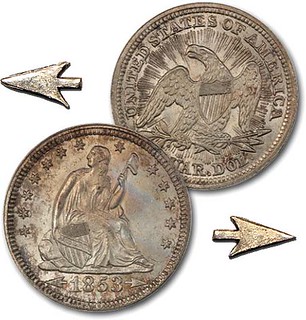 WITH THE IMPLEMENTATION of the Coinage Act of 1853, arrows were added to the designs of half dimes, dimes, quarters and half dollars. The arrows served as an announcement that the required silver content in new Liberty Seated silver coins had been reduced. The purpose of the announcement was to encourage people to spend new silver coins rather than saving, hoarding, melting or trading them. Why, though, were such arrows removed by 1856?
WITH THE IMPLEMENTATION of the Coinage Act of 1853, arrows were added to the designs of half dimes, dimes, quarters and half dollars. The arrows served as an announcement that the required silver content in new Liberty Seated silver coins had been reduced. The purpose of the announcement was to encourage people to spend new silver coins rather than saving, hoarding, melting or trading them. Why, though, were such arrows removed by 1856?
From 1856 until 1873, the silver content of silver coins continued to be in line with the Coinage Act of 1853. A law in 1873 led to the restoration of arrows on dimes, quarters and half dollars for reasons that are different from the reason that arrows were added to Liberty Seated coins, except silver dollars, in 1853.
Should arrows have continued in place after 1855 to indicate that post-1853 silver coins were specified to contain less silver than pre-1853 Liberty Seated silver coins of the same respective denominations and design types? The reason for the reduction in silver content relates to the value ratio of silver to gold.
The Coinage Act of 1792 established an official government ratio of silver to gold of 15:1. There was an official U.S. government policy of bimetallism, meaning both gold and silver were underpinnings of the monetary system. The U.S. dollar was based on the Eight Reales silver coin (Spanish Milled Dollar) of the Spanish Empire. Even so, one U.S. Dollar was defined as a weight in silver and separately as a weight in gold, with the idea that U.S. silver coins and U.S. gold coins would be interchangeable and that deposits of silver or gold could be freely exchanged at the mint for coins. The U.S. Mint then accepted deposits in silver and gold and minted coins for the depositors.
While the official government ratio stayed the same, the market ratio of the value of silver to the value of gold fluctuated. By the early 1830s, it became financially worthwhile for speculators in the U.S. to sell U.S. gold coins to traders in Europe for amounts greater than the face values of the respective coins. In the early 1830s, U.S. gold coins almost entirely disappeared from circulation in the U.S.
The official government ratio of silver to gold was changed by law in 1834 from 15:1 to 16:1. In other words, the value of one Troy ounce of gold was increased to sixteen Troy ounces of silver. Gold was legislated to be worth more than it was before, and the gold content of each new U.S. gold coin was thus reduced so gold coins would be spent rather than melted or exported. This change in ratio was an adjustment to market realities.
In the early 1850s, an opposite scenario manifested itself. The free market exchange rate of silver to gold dropped below 16:1. The value of one unit of weight of silver increased to the point that it was significantly above one-sixteenth (0.0625) of one unit of weight of gold. The value of gold decreased because massive quantities of gold were discovered in California in 1849.
In the early 1850s, the value of silver as bullion rose to the point that silver coins were worth more in bullion terms than their respective face values. For example, the silver in ten half dollars was worth more than one half eagle (U.S. $5 gold coin). By the early 1850s, there was a massive shortage of silver coins in circulation; very few people spent them in the United States.
To read the complete article, see:
Why Were Arrows Removed From Silver Coins by 1856?
(https://www.greysheet.com/news/story/why-were-arrows-removed-from-silver-coins-by-1856)
FIRST 1878-S MORGAN DOLLARS STRUCK
Roger Burdette published an article for CoinWeek on the first Morgan dollars struck at San Francisco. Here's an excerpt - see the complete article online for more information. -Editor
The first standard Morgan Silver Dollars designed by George T. Morgan were struck at the San Francisco Mint on April 17, 1878. A box containing 10 pairs of dollar dies was shipped on April 8 and arrived at the Mint on the evening of April 16. The dies were apparently numbered one through 10 for both obverse and reverse.
On the morning of April 17, Superintendent Henry L. Dodge notified San Francisco newspapers that Morgan silver dollar dies had arrived and that the first coins would be struck at 3:30 PM at the Mint. Nearly all daily newspapers sent reporters, and several other people were either invited or learned of the event.
Coiner Frank X. Cicott acted as master of ceremonies and likely explained what was going to happen for those in attendance. Superintendent Dodge placed the first planchet in the collar surrounding the lower, reverse die of the large Ajax press. The power drive belt had been disconnected, so Mint employee Thomas C. Maher turned the large flywheel manually. The large toggle joint clicked, driving the upper, or obverse, die into the planchet and producing the first San Francisco silver dollar of the new design.
Nearly 1,000 were struck off when a die cracked, and the press was stopped.
Nothing tells us which die cracked, although Dodge's statement of eight reverse dies condemned
could be a suggestion that it was the reverse that failed. If correct, we should not have any more coins from that die pair than the ±1,000 mentioned. There is no evidence that any dies except the initial pair were used on the 17th.
Telegram dated April 17, 1878, notifying Mint Director Henry Linderman that the dies had arrived and the first Morgan dollar had been struck at San Francisco Mint.
We can establish which die pair was used on April 17 by examining a unique coin.
This is an 1878-S dollar engraved with the words, one of the first ten coined april [sic] 17th from j. gus. burt
in neat capital letters. Examination by Morgan Silver dollar specialists at VAMWorld has established that this coin is a variety known as VAM 60
. The reverse has a long center arrow shaft. The S mintmark is punched high and left in relation to the wreath bow. The identical obverse die was used to make VAMs 26 and 57, but no other coins are known from this reverse die.
The clear deduction from our physical and historical evidence is that the first 1,000 standard silver dollars were produced at the San Francisco Mint during the afternoon of April 17, 1878. All of these coins were struck on the large Ajax press from a single pair of dies. After somewhat less than 1,000 pieces were made, the reverse die cracked and was condemned. No further coins were made from this pair of dies. This die combination is known as VAM 60. All initial production coins were made from this pair of dies, and this pair only.
To read the complete article, see:
Roger Burdette: First 1878-S Morgan Silver Dollars Struck
(https://coinweek.com/us-coins/roger-burdette-first-1878-s-morgan-silver-dollars-struck/)
To read an earlier E-Sylum article, see:
THE FIRST MORGAN DOLLARS STRUCK IN SAN FRANCISCO
(https://www.coinbooks.org/v22/esylum_v22n35a21.html)
THE U.S.S. MERRIMACK RELIC MEDAL
A Stack's Bowers blog article by Chris Bulfinch discusses the Merrimack relic medal. A relic medal is a "made-from" medal, using metal taken as a souvenier from some historical artifact like a status, bell, building or in this case, a ship. -Editor
Many numismatic items, including Civil War tokens and medals, honor the Battle of Hampton Roads, the 1862 naval battle that saw the first direct engagement between ironclad warships. Among the most interesting are relic medals
produced with metal recovered from the wreck of the C.S.S. Virginia (formerly the U.S.S. Merrimack, named for a river that runs from central New Hampshire into northern Massachusetts). We're offering one such medal in lot 2220 of our upcoming Spring 2023 Expo Auction.
The Confederacy scuttled the Virginia, an ironclad ram built on the hull of the U.S.S. Merrimack, months after Hampden Roads to prevent its capture by Union forces. Extensive salvage operations began in the 1860s and continued into the 1870s. By 1876, much of the wreck had been recovered, according to the National Underwater and Marine Agency's website (https://numa.net/expeditions/merrimack-u-s-s/). From the armor plating a number of medals were struck.
The type offered in our Spring Expo Auction, cataloged as ME-1 in David Schenkman's Tokens & Medals Commemorating the Battle Between the Monitor and Merrimac, bears simple designs, depicting on its obverse the Virginia/Merrimack surrounded by text reading THE FIRST IRONCLAD
with the date below. The reverse is even less adorned, with simple text reading MADE FROM THE ARMOUR PLATE OF THE MERRIMAC[sic]
This Merrimack medal was listed as a Civil War token in early editions of the Fuld reference, though it was delisted decades ago. In a brief email interview, Schenkman described the medal as a popular token, even though it is no longer considered a Civil War token.
Schenkman also explained that medals were produced from the Virginia/Merrimack's armor from the mid-19th century to the 1920s.
We're offering this medal in Session 2 of our Spring 2023 Auction, which is dedicated to Numismatic Americana and Early American Coins. Additional Numismatic Americana can be found in our Internet-Only Session 10. To view this lot and the rest of our upcoming Whitman Expo Auction please visit StacksBowers.com.
To read the complete lot description, see:
"1862" The First Ironclad Medal. Schenkman-ME1. Iron, from the Merrimac. AU Details--Obverse Damage (NGC).
(https://auctions.stacksbowers.com/lots/view/3-11DQ84/1862-the-first-ironclad-medal-schenkman-me1-iron-from-the-merrimac-au-details-obverse-damage-ngc)
To read the complete article, see:
DID YOU KNOW THAT MEDALS WERE MADE FROM THE ARMOR OF THE IRONCLAD VIRGINIA/MERRIMACK?
(https://stacksbowers.com/did-you-know-that-medals-were-made-from-the-armor-of-the-ironclad-virginia-merrimack/)
THE BOOK BAZARRE
MEDAL OF HONOR FOR COL. PARIS D. DAVIS
At a White House ceremony this week, Retired Army Col. Paris Davis received the Medal of Honor. -Editor
President Joe Biden on Friday awarded the Medal of Honor to retired Army Col. Paris D. Davis for what the White House called "conspicuous gallantry" during combat operations in the Vietnam War — a recognition that comes almost 60 years after the actions that earned him the nation's highest military award for valor.
Davis, who was a captain at the time, "distinguished himself by acts of gallantry and intrepidity above and beyond the call of duty" while he was a commander of a special forces group during combat with the enemy over two days in June of 1965, the White House said in a description of Davis' heroic actions.
Over the course of 20 hours, Davis "had saved each one of his fellow Americans — every single one," Biden said at the White House ceremony, attended by Defense Secretary Lloyd Austin and Veterans Affairs Secretary Denis McDonough.
"Paris, you are everything this medal means," Biden said. "You're everything our generation aspired to be. You're everything our nation is at our best — brave and big-hearted, determined and devoted, selfless and steadfast, American."
Biden described in detail how Davis went to great lengths to rescue his fellow Americans in Vietnam, which involved multiple failed attempts to reach them while under enemy fire and him being wounded several times.
The two-day ordeal began in Bong Son, Vietnam, where Davis was commanding an "inexperienced South Vietnamese" force and learned that a "vastly superior North Vietnamese enemy force" was in the area. "Through surprise and leadership, he gained the tactical advantage, personally engaging and killing several enemy soldiers," during which he was wounded and then entered into hand-to-hand combat, the White House said in a release.
To read the complete article, see:
Biden awards Medal of Honor to Black Vietnam War veteran who rescued fellow Americans
(https://www.nbcnews.com/politics/white-house/biden-award-medal-honor-black-vietnam-war-veteran-rcna73227)
The Army says Col. Davis is now one of four service members to receive both the Medal of Honor and the Soldier's Medal, an award given for an act of heroism that doesn't involve enemy conflict. He received the Soldier's Medal after saving the life of a soldier in Vietnam who was stuck in an overturned fuel truck just before it exploded.
After his military career, Col. Davis founded the Metro Herald, a newspaper in Alexandria, Va., that he published for roughly 30 years. It closed in 2018.
To read the complete article, see:
Col. Paris Davis, One of First Black Officers in Army's Special Forces, Receives Medal of Honor
(https://www.wsj.com/articles/col-paris-davis-one-of-first-black-officers-in-armys-special-forces-receives-medal-of-honor-d7b988c2)
Davis earned a Silver Star for his actions. His commanding officer immediately put him up for the Medal of Honor. The paperwork was subsequently lost. When it was submitted a second time, it was lost again.
"One of the great things about being Paris Davis, [is] there are times when other people speak for you," the retired colonel told Military.com on Thursday.
He had just recounted a phone call he received the day prior. A general -- Davis did not catch his name -- had called him. He asked Davis why it had taken so long for him to receive the Medal of Honor.
"And I said, 'You're probably in a better place to know than me," Davis said. The general told him that he believed the award was not processed due to racism.
"This is a general talking," Davis said. "And that's probably my answer too."
Amid the heraldry, celebration and reverence, the underlying question of what took so long for Davis to get the Medal of Honor lay beneath the festivities Thursday at the Sheraton Hotel Pentagon City, where current and former Special Forces members, family and friends talked to the media.
For many of Davis' supporters, the answer to that question was also racism. At the height of the civil rights movement of the 1960s, Davis was a Black Special Forces officer who had refused an order from a superior. Davis said he was reprimanded for the refusal, and believes it likely prevented him from reaching the rank of general officer. He retired from the military in 1985.
To read the complete article, see:
Paris Davis, Black Green Beret in Vietnam, Finally Awarded Medal of Honor at White House
(https://www.military.com/daily-news/2023/03/03/paris-davis-black-green-beret-vietnam-finally-awarded-medal-of-honor-white-house.html)
1648 PERPETUAL DUTCH BOND STILL PAYS INTEREST
John Mellman passed along this interesting article from Yale Alumni Magazine about a 375-year-old Dutch bond that still pays interest. Thanks! -Editor
One of Yale's most intriguing investments is a 375-year-old perpetual
Dutch bond that still pays interest. It was issued by the Hoogheemraadschap Lekdijk Bovendams, a semi-public organization charged with maintaining the dike along the Lek river in the Netherlands. The water authority was founded in 1323; its successor still operates today, in the province of Utrecht, as the Stichtse Rijnlanden. This is where Yale Beinecke curator Timothy Young showed up in 2015 to collect twelve years of past interest payments, amounting to 132 euros. The authority was glad to pay. There are few entities in the world that can claim such a long, continuous history of good credit.
Only about five such bonds are known to have survived from the Dutch Golden Age. Yale's was issued in 1648, the same month in which the Treaty of Munster ended the Eighty Years' War by recognizing the sovereignty of the Dutch Republic. The Lekdijk bond is a reminder that in the sixteenth and seventeenth centuries, the Dutch fought a war on two fronts: a war of independence from Spain and a battle against water.
The bond shows us exactly how the seventeenth-century Dutch were able to raise enough capital to build and maintain their remarkable system of dikes, canals, and polders (lands reclaimed from the water). In a sense, bonds like these made the modern Netherlands possible. A key financial innovation was the Hoogheemraadschap water companies. They were endowed with the extra-governmental power of taxation, and even the extraordinary right to mobilize citizens into dike armies
to support the upkeep of the waterworks in case of an emergency. This novel organizational form was able to maintain the vital infrastructure of the dike system, irrespective of the vagaries of war, politics, and financial crises, and its power to tax insured that its bondholders would get paid. This allowed for the full payment of interest on the Yale bond—even in 1810, when the Netherlands defaulted on its sovereign obligations after the annexation by France.
The document is more than an interesting historical curio. The text reveals precisely the conditions under which the investors were willing to provide necessary capital. In the text, Johan van Hogenhouck, the Cameraer of Lekdijk Bovendams, promises to pay Niclaes de Meijer, the Canonick of Oudemunster, or his successors or assigns, 50 guilders per year in perpetuity in exchange for his 1,000-guilder capital contribution. Hogenhouck represented the company and its directors; de Meijer was the canon of one of Utrecht's oldest churches. Although the Oudemunster church is now gone, its handsome sixteenth-century Canonick's house is still standing. De Meijer appears to have bought the bond as a personal investment, and he likely regarded it as fairly safe. The five percent yield on the 1648 Lekdijk bond was similar to the yield on Dutch government securities at the time—suggesting that investors considered the promised payments of a Hoogheemraadschap to be as safe as those of the newly recognized nation.
Written, signed, and sealed on vellum, the Lekdijk instrument was a thoughtfully designed tool meant to survive centuries. It functioned quite simply. The text makes clear that the bond was transferable, and payment was to be made to the bearer of the security, not to someone listed in a registry. Presented at the company offices, payment was made and then recorded directly in the margins or on the back of the instrument. Not surprisingly, the front and back are covered with records of annual interest payments that began in 1648 and continued to 1943, at which time a paper document, called an allonge, was created to continue the recording of interest payments.
When Yale acquired the document in 2003 at auction, we learned that payments had to be collected in person. School of Management finance professor Geert Rouwenhorst picked up the bond and collected the unpaid interest due from 1977 to 2003. Beinecke curator Timothy Young presented the allonge in 2015 at the Stichtse Rijnlanden offices to collect the subsequent twelve years of payments. The latter amounted to the equivalent of $153. Inflation since 1648 had taken its toll—as did a seventeenth-century reduction in the interest rate by half. Writing the receipt for payment right on the document was a clever way to ensure that the bondholder could not claim they had not been paid.
The text also explains precisely what the borrowed money would be used for: to pay workers to repair the new cribbing on a curve of the Lek river near the town of Honswijk, part of a five-mile stretch of dike just outside the city of Utrecht. Cribbing is a system of piers that extends into the river current and is designed to prevent erosion. Though the town of Honswijk has mostly disappeared, the dike holding back the Lek and the cribbing protecting it are plainly visible in Google Earth. Not only does Stichtse Rijnlanden continue to honor the terms of the promise made to Niclaes de Meijer in 1648, but it also maintains the same Lek cribbing at the Honswijk dike. The water company has repaired and likely refinanced the cribbing regularly through the centuries.
To read the complete article, see:
Infinity has a price
(https://yalealumnimagazine.org/articles/5627-infinity-has-a-price)
COURT HALTS NIGERIA'S BANKNOTE ROLLOUT
We recently discussed Nigeria's new banknotes. Their rollout has been shambolic, and was recently ruled invalid by the country's highest court. -Editor
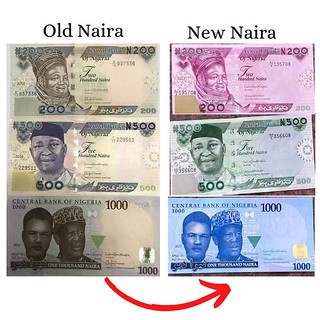 Nigeria's botched attempt to replace its banknotes has been declared invalid by the country's Supreme Court.
Nigeria's botched attempt to replace its banknotes has been declared invalid by the country's Supreme Court.
In a ruling Friday, the country's highest court said a presidential directive to discontinue the use of old naira notes following a redesign was illegal. The court said the old banknotes should continue to be legal tender, alongside new versions, until the end of this year.
Nigeria's old 200-, 500-, and 1,000-naira ($2.17) notes ceased to be legal tender starting February 11, sparking violent protests across the country as millions of people struggled to get their hands on the redesigned money. That prompted a partial retreat by the government, which agreed to reissue the old 200-naira notes for a limited period of time.
President Muhammadu Buhari unveiled the new-look currency in November last year with the aim of reining in counterfeiting and the hoarding of large sums of money outside the banking system. But banks have been unable to disburse enough of the new naira, leaving many Nigerians lining up at cashpoints in a desperate bid to get enough cash to meet their daily expenses.
The cash crunch has led to frayed tempers and hardship, particularly among those who work in the cash-based informal economy and for citizens who live in rural areas.
Violent protests have been recorded in parts of the country. Some people have died during the protests, local media have reported, and bank branches have been damaged.
To read the complete article, see:
Nigeria's chaotic banknote switch ruled invalid by top court
(https://www.cnn.com/2023/03/03/business/nigeria-banknotes-supreme-court/index.html)
To read the earlier E-Sylum article, see:
NIGERIANS UNIMPRESSED WITH NEW BANKNOTES
(https://www.coinbooks.org/v25/esylum_v25n48a27.html)
Thanks also to Dick Hanscom, who sent along this BBC News article. -Editor
To read the complete article, see:
Nigeria's Supreme Court rules CBN naira redesign invalid
(https://www.bbc.com/news/world-africa-64837041)
ATMS DISAPPEARING ALONG WITH CASH USAGE
My lunch tab yesterday ended in 29 cents. I handed the fast-food cashier a $20 bill and four cents, asking "Can you handle this?" A lot of them can't. One young woman a few weeks ago shorted me on the change but insisted she was right until a manager came over to help. I don't know if that was an issue of math-savvy or cash-savvy, but cash in general continues its relentless decline. This Wall Street Journal article looks at the declining number of ATMs. -Editor
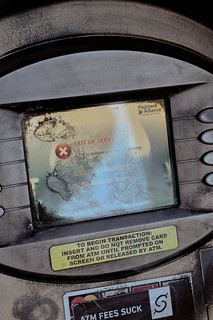 The slow move toward a cashless society is helping to send the ubiquitous ATM into decline around the U.S., presenting challenges for those who still largely rely on cash.
The slow move toward a cashless society is helping to send the ubiquitous ATM into decline around the U.S., presenting challenges for those who still largely rely on cash.
After peaking at 470,000 ATMs in the U.S. in 2019, the number of machines has declined annually over the past few years to 451,500 at the end of 2022, according to data tracked by research firm Euromonitor International. The reason: Many people quit using cash during the pandemic and haven't gone back, said Kendrick Sands, consumer finance research manager for the London-based firm.
There was that scare that the virus was transmitted by paper, plus the trend of just buying everything online,
said Mr. Sands, who is based in Chicago. That dealt almost a death blow to cash, especially for younger people.
Cash and checks are forecast to fall to 14% of total payments this year from 42% in 2010, with the most precipitous drop coming just after the pandemic started in 2020, according to Euromonitor estimates.
Zach Alan, a 64-year-old retiree from South Carolina, said he withdrew about a third less cash in 2022 compared with 2019, as part of his conversion to putting almost every transaction on points-accruing credit cards.
More people are opting to send money digitally for money needs such as allowances, tips and splitting bills via payment apps like PayPal Holding Inc.'s namesake platform and Venmo, and Block Inc.'s Cash App.
That kind of behavior is likely to persist, according to a Federal Reserve study on payments during the pandemic. The study documented a 12.4% jump in digital transactions between individuals from the first quarter of 2020 to the second. People making those transactions for the first time jumped 18% over the same period.
The pandemic accelerated the transition from cash to digital payments, but ATMs remain key to the nation's banking system, said Sarah Grano, spokeswoman for the American Bankers Association.
Officials from the ATM Industry Association questioned the Euromonitor numbers, saying that while the dispensers were hit hard during the pandemic they see a rebound in demand for cash. It is still the payment method of choice for in-person transactions of $25 or less,
said David Tente, the group's executive director for the U.S. and Latin America.
ATMs revolutionized banking. First deployed in London in 1967, the machines provided a way for customers to access their money outside of the narrow banking hours. When Chemical Bank rolled out the first one in the U.S. in 1969, it promised customers in an advertisement that it would never close again. Paul Volcker, a former Federal Reserve chairman, quipped in 2009 that the most important financial innovation that I have seen the past 20 years is the automatic teller machine.
But their falling numbers mean less access for people who still need them. In Kansas City, Mo., hotel bartender AJ Barbosa said the stand-alone ATMs he relies on to deposit cash near his downtown home are less dependable. Those cash tips have to get in our account somehow and ATMs are usually how we do it,
said Mr. Barbosa, 31.
To read the complete article, see:
The Number of ATMs Has Declined as People Rely Less on Cash
(https://www.wsj.com/articles/the-number-of-atms-has-declined-as-people-rely-less-on-cash-81268fa2)
1948 CIA DOCUMENT DISCUSSING COUNTEFEITING
The Geldscheine Online site has an article about a declassified 1948 CIA document discussing counterfeiting. Here's a Google-translated excerpt. -Editor
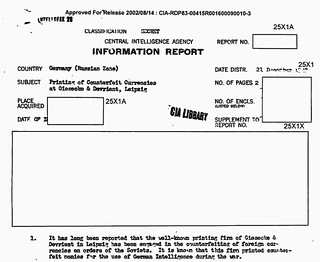 True or not true – that is the question here. Secret papers from the US foreign intelligence service CIA bring a surprise to light:
True or not true – that is the question here. Secret papers from the US foreign intelligence service CIA bring a surprise to light:
A report released in August 2002 made outrageous claims. Here's how to read in seven points:
1. It has long been reported that the well-known printers Giesecke & Devrient in Leipzig were involved in the counterfeiting of foreign currency on behalf of the Soviets. This company is known to have printed counterfeit funds for German intelligence during the war.
2. The factory was dismantled by the Russians and the best and most modern machines were removed and sent to Russia for reparations. A good part of the former staff was also taken out of the country. A few months later, the Russians planned to resume counterfeiting work and part of the factory was eligible for this work. Several presses were brought back from Russia, but most of the special equipment was no longer found. The crates of machine parts came back, but it took a lot of effort to assemble enough equipment to do the engraving and imprinting of counterfeit money.
3. Currently the focus is on the reproduction of US Treasury $10 bills, US Military $10 bills and UK one pound notes.
4. The counterfeiting department now has eight employees, four of whom are German and four Russian. The Germans were closely guarded at work and outside. They bring the technical skills necessary for the job, while the Russians have the supervisory functions. Strict records are kept of all stocks of paper and other supplies, as well as of finished notes and all waste.
5. The production target for the four months beginning October 1948 was as follows: USA Treasury Notes 10 Dollars 100,000 USA Military Notes 10 Dollars 85,000 English Notes 1 Pound 10,000 On October 23, 1948 the following quantities were completed and delivered: USA Treasury Notes $10 10,000 US Military Bills $10 20,000 This was approximately twenty percent less than the scheduled delivery for the period and delivery was two days later than expected.
6. The paper for the counterfeiting is made by a small company in the Russian zone that works exclusively for Giesecke & Devrient. The inks are said to be American products. Only Russian employees take care of the containers, who give the paints to the German craftsmen in small containers as needed.
7. Various counterfeit papers are printed in other departments of the plant. These include ID cards, ID cards, bills of lading, vehicle registration documents and driver's licenses as used in the United States, England, France, the Netherlands, Sweden and the three western zones of Germany. Dutch passports are now being produced and are said to have visa stamps for the Dutch colonies. The powers of attorney for the West Sector Police in Berlin have recently been issued.
However, if the CIA report is to be believed, only 10 percent of the Treasury Notes were printed and shipped...and then the 1890/1891 $10 bills were said to have been counterfeit. But those were the large-format bills, the so-called Large Size Notes; presumably small size notes were printed. And there, in turn, different issues would come into question: Gold Certificates, Silver Certificates, Federal Reserve Notes or National Bank Notes.
The large-format treasury notes would have been a great challenge for the Leipzig forgers in terms of printing technology and it is questionable whether the originals produced in steel engraving would have been close. Presumably, if at all, banknotes dated 1934 and with different signatures were forged. A US Army high command warning of counterfeit US currency bills involved 18 cases within 6 months as early as 1946, a military detective reported in the Army newspaper Stars and Stripes.
To read the complete article, see:
75 Jahre alte CIA-Dokumente sagen aus
(https://www.geldscheine-online.com/post/75-jahre-alte-cia-dokumente-sagen-aus)
LOOSE CHANGE: MARCH 5, 2023
Here are some additional items in the media this week that may be of interest. -Editor
A Numismatic News article by Rich Giedroyc describes talks given at the January NYINC show by Dr. Ursula Kampmann and David Vagi. -Editor
Both the business and hobby of coins are both changing. Coin collecting simply isn't your grandfather's collecting anymore. Fortunately for the future, the hobby and the business are changing with the times, this being something not all other collectible fields are doing. Two speakers at the recent New York International Numismatic Convention likely didn't realize that their presentations dovetailed, illustrating not only where the hobby has come from, but where it is going.
To read the complete article, see:
Coin Collecting is Changing
(https://www.numismaticnews.net/world-coins/coin-collecting-is-changing)
Mark Hotz published another nice National Bank Note article, this time on Rockwood in Somerset County, Pennsylvania. -Editor
This month we will continue a visit to Western Pennsylvania to visit a town from which I just added a very nice grade large note to my collection. In rural Somerset County, southeast of Pittsburgh and close to the Maryland line, let's visit quaint Rockwood, Penn.
In the late 19th Century, Rockwood experienced significant growth as a result of the industrial revolution. The Rockwood Mill, a textile factory, was built in 1891 and attracted many workers to the area. The mill played a large role in the development of the town and in recent years was converted into the Rockwood Mill Shoppes and Opera House, which has become a tourist attraction. Rockwood also had a thriving coal industry. The Rockwood Electric Generation Station was built in 1904 and continues to operate today. It continues to be a major employer in the area.
The considerable economic activity in Rockwood resulted in the founding of not one but two national banks. The First National Bank of Rockwood, charter #5340, opened in May of 1900, a typical Gold Standard Act bank. It was closed by the receiver on April 20, 1934. In the 34 years of its operations, it issued a paltry $512,000 in notes, of which just $25,000 was outstanding at the close. I recently obtained a rather Choice XF large size note on this bank, which nicely filled my slot for this small bank. I have included a photo with this article. Note the strong signatures of J.R. Shanks, cashier, and H.F. Berkbile, president. The current census shows 5 large and 4 small notes reported, of which my large note is the finest known by far.
To read the complete article, see:
Two Banks, One Small Town
(https://www.numismaticnews.net/paper-money/two-banks-one-small-town)
Last we we discussed Ukraine's commemorative banknote marking the one year anniversary of the Russian invasion. They've also issued a stamp featuring an artwork by Banksy. -Editor
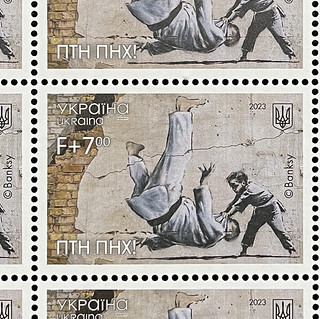 On February 24, the first anniversary of Russia's ongoing war in Ukraine, the Ukrainian postal service released a new stamp featuring a Banksy mural and the shorthand
On February 24, the first anniversary of Russia's ongoing war in Ukraine, the Ukrainian postal service released a new stamp featuring a Banksy mural and the shorthand FCK PTN!
in Cyrillic. The mural, which the British street artist painted in the fall of 2022 on a bombed building northwest of Kyiv, portrays a young boy in Judo robes flipping an older man. Many speculate Banksy depicted Vladimir Putin getting body slammed, as the Russian President is reportedly a Judo practitioner.
In a press statement, the national post shared that the image is allegorical,
representing the struggle between Ukraine and Russia. Our small country, compared to Russia, courageously entered into an unequal battle with the enemy and, despite all the difficulties, is fighting for the Victory,
wrote Ukrposhta.
Banksy had completed seven murals in Borodyanka, including a painting of a gymnast performing a handstand in 2022. The town had been devastated by Russian forces early on in the war and was briefly occupied until Russian troops withdrew in April. The murals allude to and celebrate Ukrainians' spirit and courage during the war.
To read the complete article, see:
Ukraine Marks First Year of War With Banksy Stamp
(https://hyperallergic.com/803952/ukraine-marks-first-year-of-war-with-banksy-stamp/)
To read earlier E-Sylum articles, see:
WAYNE'S NUMISMATIC DIARY: MAY 22, 2022 : Ukrainian Banknotes, Stamp Money, and a Famous Stamp
(https://www.coinbooks.org/v25/esylum_v25n21a19.html)
UKRAINE BANKNOTE MARKS ONE YEAR OF WAR
(https://www.coinbooks.org/v26/esylum_v26n09a33.html)
FEATURED WEBSITE: CALIFORNIA GOLD
This week's Featured Web Site is Mike Locke's site on California fractional gold coins and tokens.
 After the discovery of large deposits of gold in California in 1848 there was a huge influx of people to California. Many of these new arrivals brought little money with them. Combined with the geographically isolated location of California, this produced a lot of people with gold but no money. Several private firms produced gold coins denominated as $5, $10, $20, and $50, mostly in the 1849 to 1853 time frame. This activity filled the need for money for large transactions, but left no means to make change for more ordinary purchases. Although a number of solutions to the small change problem were tried, the subject of study here are the gold $0.25, $0.50 and $1 pieces made by private mints beginning in 1852.
After the discovery of large deposits of gold in California in 1848 there was a huge influx of people to California. Many of these new arrivals brought little money with them. Combined with the geographically isolated location of California, this produced a lot of people with gold but no money. Several private firms produced gold coins denominated as $5, $10, $20, and $50, mostly in the 1849 to 1853 time frame. This activity filled the need for money for large transactions, but left no means to make change for more ordinary purchases. Although a number of solutions to the small change problem were tried, the subject of study here are the gold $0.25, $0.50 and $1 pieces made by private mints beginning in 1852.
Although these small coins never acheived large scale circulation, by late 1853 they had gained popularity as souvenirs that could be economically mailed home. The gold content of these small coins started out rather low and once they became popular as souvenirs the weights dropped even farther. Congress passed 2 coinage acts in 1864 that effectively banned privately produced coins, but the law was not fully enforced until 1883. During the period of partial enforcement of the coinage act of 1864, one mint tried using gold rush era dates in order to avoid attracting attention. Although production was more-or-less stopped in 1883, it resumed in 1884 with pieces that lacked a dollar value claim on the design. These later pieces are called tokens by the collecting community. The backdating practice of 1864-1883 was adopted by most mints in the post 1883 time frame.


